Selected
Takao 599 museum has all kinds of animals inhabit in Mt. Takao in various ways of exhibitions such as seasonal wild plants preserved in acrylic and all kinds of animals specimens inhibits in Mt. Takao. On the "NATURE WALL," stuffed animals are displayed and shows the movie to introduce the dynamic nature of Mt. Takao.
-
Viola japonica Violaceae
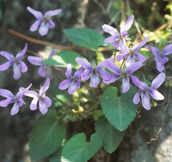
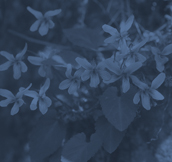 Viola japonica Violaceae
Viola japonica Violaceae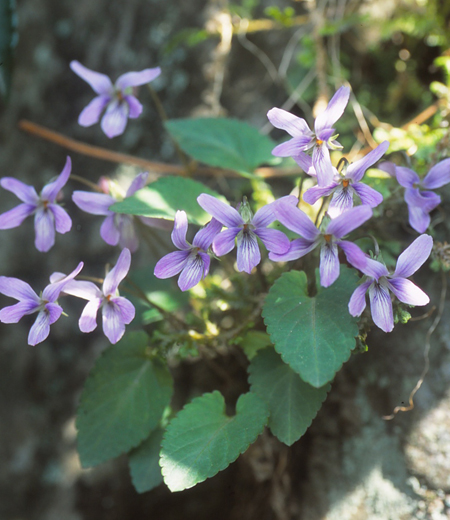 Perennial herbs found on sunny forest floor in low elevations, roadside, riverbank and near residential areas. One of violas starts to bloom in early spring. In Mt. Takao, found in sunny south-facing slopes. The Japanese name Ko-sumire literally meaning small viola but this plant is not small and flowers are 2 cm in diameter. Have purple lines radiating from the center of petals and petals are mainly purple but some are white. Leaves are 2 to 5 cm, elongated triangular to oval-shaped with pointed tip. The back of leaves is purplish. Have many leaves and grow rising from the ground. Similar to viola phalacrocarpa but this plant does not have hair.
Perennial herbs found on sunny forest floor in low elevations, roadside, riverbank and near residential areas. One of violas starts to bloom in early spring. In Mt. Takao, found in sunny south-facing slopes. The Japanese name Ko-sumire literally meaning small viola but this plant is not small and flowers are 2 cm in diameter. Have purple lines radiating from the center of petals and petals are mainly purple but some are white. Leaves are 2 to 5 cm, elongated triangular to oval-shaped with pointed tip. The back of leaves is purplish. Have many leaves and grow rising from the ground. Similar to viola phalacrocarpa but this plant does not have hair.
●Season Late March to about Mid April
●Height about 5 to 10 cm
●Place Trail 6, Ura-Takao -
Viola maximowicziana Violaceae
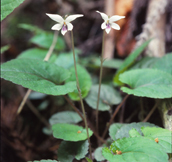
 Viola maximowicziana Violaceae
Viola maximowicziana Violaceae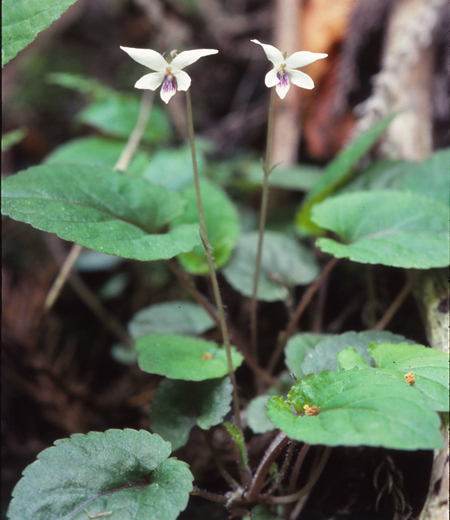 Perennial herbs found in dark and wet areas along streams. In Mt. Takao, start to bloom at the end of viola season. Large leaves are appealing but have small flowers about 1 cm in diameter. Color is white with purple lines radiates from the lower petal. Calyx at the back of petals is hairy with curled tips which is unique to this plant. Shape of leaves is round after sprout but changes to oval or egg-shaped with age. Leaves are 2 to 3..5 cm long, soft texture and not shiny with toothed margins. The back of leaves is purplish. At the end of blooming season, have many self-pollinate cleistogamous flower which does not open.
Perennial herbs found in dark and wet areas along streams. In Mt. Takao, start to bloom at the end of viola season. Large leaves are appealing but have small flowers about 1 cm in diameter. Color is white with purple lines radiates from the lower petal. Calyx at the back of petals is hairy with curled tips which is unique to this plant. Shape of leaves is round after sprout but changes to oval or egg-shaped with age. Leaves are 2 to 3..5 cm long, soft texture and not shiny with toothed margins. The back of leaves is purplish. At the end of blooming season, have many self-pollinate cleistogamous flower which does not open.
●Season Late April to about Mid May
●Height about 5 to 8 cm
●Place Trail 4, Trail 6, Ura-Takao -
Viola mandshurica(Violet) Violaceae
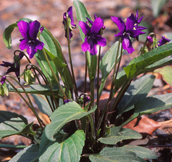
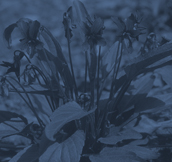 Viola mandshurica(Violet) Violaceae
Viola mandshurica(Violet) Violaceae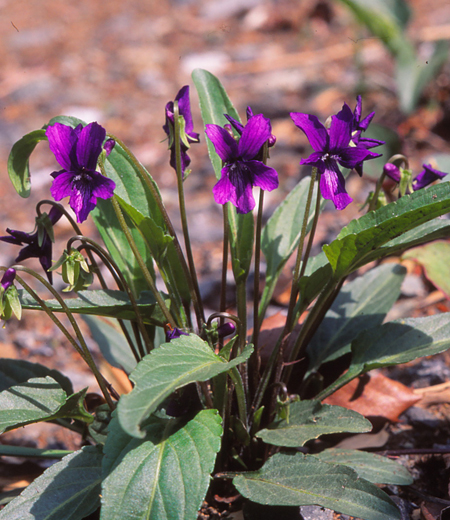 Perennial herbs found in sunny grasslands and on roadside. The numbers of this plant in Mt. Takao is decreasing but found in residential area. The Japanese name Sumire literally meaning viola was named because the shape of flowers from the sides resembles the tool of carpenters called sumi-ire meaning carpenter’s ink pod. Leaves and flowers are in cluster growing upright from the thick underground stem. Leaves are like the shape of elongated shoehorns, rounded tips, 3 to 8 cm long, thick and have wings at petioles that is unique to this plant. Flowers are 1..2 to 1.7 cm in diameter and dark purple. The lateral sepals have white hair and spur is long and about 7 mm.
Perennial herbs found in sunny grasslands and on roadside. The numbers of this plant in Mt. Takao is decreasing but found in residential area. The Japanese name Sumire literally meaning viola was named because the shape of flowers from the sides resembles the tool of carpenters called sumi-ire meaning carpenter’s ink pod. Leaves and flowers are in cluster growing upright from the thick underground stem. Leaves are like the shape of elongated shoehorns, rounded tips, 3 to 8 cm long, thick and have wings at petioles that is unique to this plant. Flowers are 1..2 to 1.7 cm in diameter and dark purple. The lateral sepals have white hair and spur is long and about 7 mm.
●Season Mid April to about Early May
●Height about 7 to 15 cm
●Place Trail 1, Trail 5, Mt. Inari, Ura-Takao, Oku-Takao -
Viola yezoensis f. discolor Violaceae
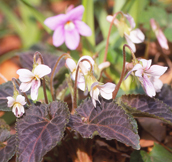
 Viola yezoensis f. discolor Violaceae
Viola yezoensis f. discolor Violaceae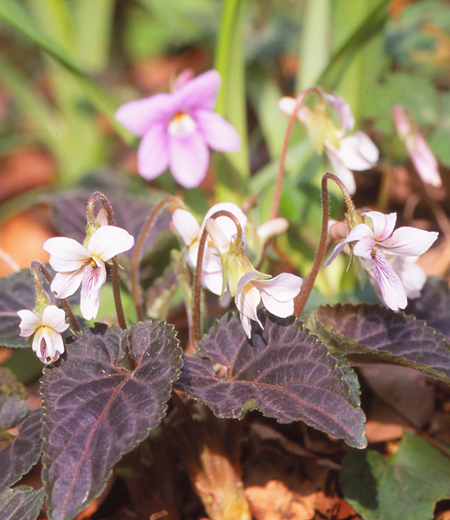 This plant represents Mt. Takao, often called as “the mountain of viola.” Found at wet and half shady forest edges along streams. The Japanese name Takao-sumire literally meaning Mt. Takao viola was named because it was first found in Mt. Takao. It inhabit throughout Japan but many of them found in Mt. Takao. It was first introduced as a varietas of viola yezoensis in 1928 (Showa Era 3). The front side of leaves is dark brown during blooming season that is unique to this plant. After flowering, green leaves grow which makes it difficult to identify them from viola yezoensis. Flowers are 1..5 to 2 cm in diameter and slightly scented. Color of flowers is white with purple fine lines radiating from the center of petals. Leaves are 3 to 6 cm and egg-shaped or elongated egg-shape.
This plant represents Mt. Takao, often called as “the mountain of viola.” Found at wet and half shady forest edges along streams. The Japanese name Takao-sumire literally meaning Mt. Takao viola was named because it was first found in Mt. Takao. It inhabit throughout Japan but many of them found in Mt. Takao. It was first introduced as a varietas of viola yezoensis in 1928 (Showa Era 3). The front side of leaves is dark brown during blooming season that is unique to this plant. After flowering, green leaves grow which makes it difficult to identify them from viola yezoensis. Flowers are 1..5 to 2 cm in diameter and slightly scented. Color of flowers is white with purple fine lines radiating from the center of petals. Leaves are 3 to 6 cm and egg-shaped or elongated egg-shape.
●Season Early April to about Early May
●Height about 5 to 12 cm
●Place Trail 1, Jyataki, Ura-Takao -
Viola bissetii Violaceae
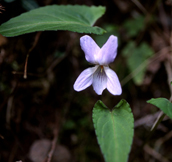
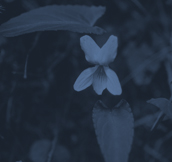 Viola bissetii Violaceae
Viola bissetii Violaceae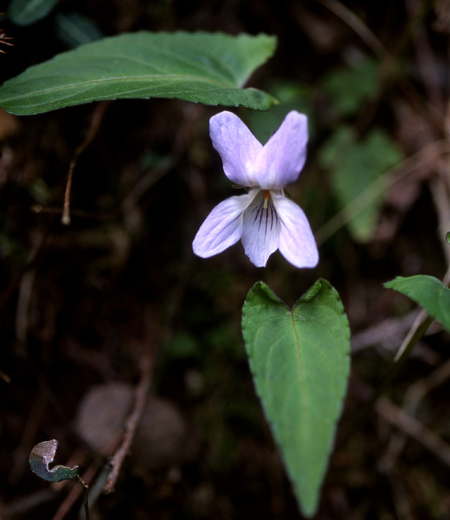 They are a perennial plant that grows at the pool in the humid forests and in the forests along the mountain stream during the early spring (Perennial plant takes several years to grow). As their name shows it, they are the large Viola mandshurica having long leaves. ‘Saishin’ (Asiasarum) is named after the shape of the leaf resembling the ones of Asiasarum sieboldii (Aristolochiaceae). They are distributed throughout a region of the Pacific coast, while Viola vaginata with short leaves are widely along the Japan Sea. The leaves are thin and long heart-shaped, and sprout out latter than the blossoms. Consequently, they bear the blossoms with the leaves about 5 to 8 cm long rounded. The flowers are 2 to 2.5 cm in diameter, mainly pale purple color, but we see the white ones mostly at Mt. Takao. When the flowers wither, the leaves grow larger and larger to be about 15 cm long. They develop a thick underground stalk with knots longer to expand.
They are a perennial plant that grows at the pool in the humid forests and in the forests along the mountain stream during the early spring (Perennial plant takes several years to grow). As their name shows it, they are the large Viola mandshurica having long leaves. ‘Saishin’ (Asiasarum) is named after the shape of the leaf resembling the ones of Asiasarum sieboldii (Aristolochiaceae). They are distributed throughout a region of the Pacific coast, while Viola vaginata with short leaves are widely along the Japan Sea. The leaves are thin and long heart-shaped, and sprout out latter than the blossoms. Consequently, they bear the blossoms with the leaves about 5 to 8 cm long rounded. The flowers are 2 to 2.5 cm in diameter, mainly pale purple color, but we see the white ones mostly at Mt. Takao. When the flowers wither, the leaves grow larger and larger to be about 15 cm long. They develop a thick underground stalk with knots longer to expand.
●Season Late March to about Mid April
●Height about 5 to 12 cm
●Place Trail 1 and 2, Trail 4 and 5, Ura-Takao, Minami-Takao -
Viola obtusa Violaceae
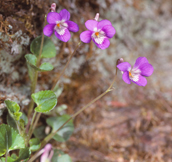
 Viola obtusa Violaceae
Viola obtusa Violaceae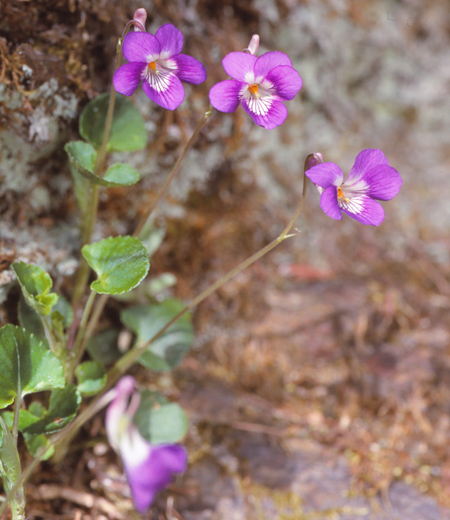 They are a perennial plant that grows at humid places such as in the plain field or under the forest in the mountain district. (Perennial plant takes several years to grow). Like Viola grypoceras, they smell slightly good smell. This is why they are named ‘Viola obtusa’. The leaf stipule (Takuyou) grown at the leafstalk (Youhei) has a split like a teeth of a comb. The flower is about 1.2 to 1.5 cm in diameter and the flower petals are roundish. Their characteristic is they are tinged with dark purple, but as a portion of the root of flower petals is white, they seem to be bright white.Tubular nectary or spur (Kyo: a portion of outpunching behind the flower petal) is thin and long about 6 to 7 mm long. The stalk and peduncle have minute whitish paraphyllium thickly. The radical leaf (KON-SEI-YO: leaf spring up from the place about stalk root) is roundish heart-shaped. The leaves grown on the stalk is the thin and sharp triangular shape about 2.5 to 4 cm long.
They are a perennial plant that grows at humid places such as in the plain field or under the forest in the mountain district. (Perennial plant takes several years to grow). Like Viola grypoceras, they smell slightly good smell. This is why they are named ‘Viola obtusa’. The leaf stipule (Takuyou) grown at the leafstalk (Youhei) has a split like a teeth of a comb. The flower is about 1.2 to 1.5 cm in diameter and the flower petals are roundish. Their characteristic is they are tinged with dark purple, but as a portion of the root of flower petals is white, they seem to be bright white.Tubular nectary or spur (Kyo: a portion of outpunching behind the flower petal) is thin and long about 6 to 7 mm long. The stalk and peduncle have minute whitish paraphyllium thickly. The radical leaf (KON-SEI-YO: leaf spring up from the place about stalk root) is roundish heart-shaped. The leaves grown on the stalk is the thin and sharp triangular shape about 2.5 to 4 cm long.
●Season Late March to about Late April
●Height about 5 to 15 cm
●Place Oku-Takao, Minami-Takao -
Viola yedoensis Violaceae
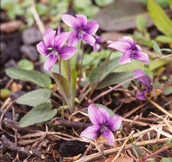
 Viola yedoensis Violaceae
Viola yedoensis Violaceae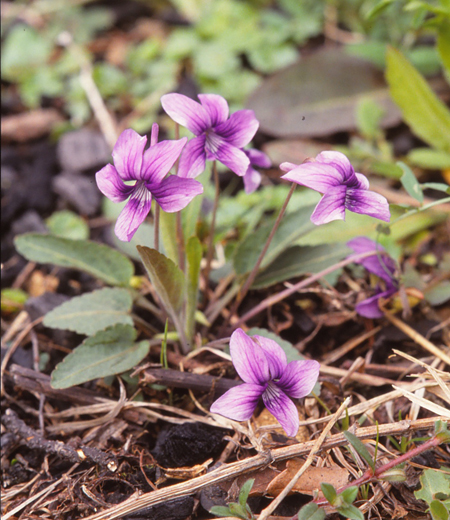 They are a perennial plant that ordinarily grows at sunny places such as he grassfields and the roadside around human habitations, or on stonewalling and in the fields. (Perennial plant takes several years to grow). The stalk and the leaf have minute whitish paraphyllium thickly. Though they resemble Viola mandshurica (Violaceae) well, the flowers of Viola yedoensis have smell and the tip of the leaf is sharp. This is how to distinguish the two. Their characteristic is they expand flat on the ground, while the leaf of Viola mandshurica grows vertically. The flower is about 1 to 1.5 cm in diameter, bluish-purple color with the flower petals striped in dark purple. The leaf is about 3 to 8 cm long, long spatulate elliptically-shaped, with the back tinged with purple, and both of the upper parts of the leafstalk (Youhei) have fins. When the flowers wither, triangular summer leaves sprout.
They are a perennial plant that ordinarily grows at sunny places such as he grassfields and the roadside around human habitations, or on stonewalling and in the fields. (Perennial plant takes several years to grow). The stalk and the leaf have minute whitish paraphyllium thickly. Though they resemble Viola mandshurica (Violaceae) well, the flowers of Viola yedoensis have smell and the tip of the leaf is sharp. This is how to distinguish the two. Their characteristic is they expand flat on the ground, while the leaf of Viola mandshurica grows vertically. The flower is about 1 to 1.5 cm in diameter, bluish-purple color with the flower petals striped in dark purple. The leaf is about 3 to 8 cm long, long spatulate elliptically-shaped, with the back tinged with purple, and both of the upper parts of the leafstalk (Youhei) have fins. When the flowers wither, triangular summer leaves sprout.
●Season Late March to about Mid April
●Height about 5 to 10 cm
●Place Trail 6, Ura-Takao, Minami-Takao -
Viola yezoensis Violaceae
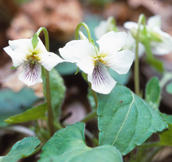
 Viola yezoensis Violaceae
Viola yezoensis Violaceae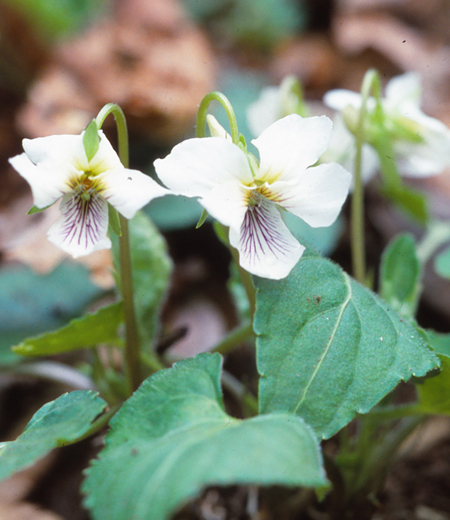 They are perennial plant that grows at such humid and partly shade places as in the forests along the mountain streams. (Perennial plant takes several years to grow). They prefer to bloom in the shades, they are named. They grow underground stems to expand and mostly grow in clusters. It is said that they are the original species of Viola yezoensis f. discolor, and that the appearance and the shape resemble well but the difference to distinguish is they bear green leaves. The leaves are heart-shaped with the sharp tip, about 3 to 6 cm long and soft feeling to touch, have minute trichome on both sides. The flowers are about 1.5 to 2 cm in diameter, good smell, tinged with white color, and have the bottom flower petal thin purple striped. Minute trichome grows thick at the root of the flower which blossom sideways. Some don’t. Tubular nectary or spur (Kyo: a portion of outpouchings behind the flower petal) is thick circular cylindrical shape about 7 to 8 mm long.
They are perennial plant that grows at such humid and partly shade places as in the forests along the mountain streams. (Perennial plant takes several years to grow). They prefer to bloom in the shades, they are named. They grow underground stems to expand and mostly grow in clusters. It is said that they are the original species of Viola yezoensis f. discolor, and that the appearance and the shape resemble well but the difference to distinguish is they bear green leaves. The leaves are heart-shaped with the sharp tip, about 3 to 6 cm long and soft feeling to touch, have minute trichome on both sides. The flowers are about 1.5 to 2 cm in diameter, good smell, tinged with white color, and have the bottom flower petal thin purple striped. Minute trichome grows thick at the root of the flower which blossom sideways. Some don’t. Tubular nectary or spur (Kyo: a portion of outpouchings behind the flower petal) is thick circular cylindrical shape about 7 to 8 mm long.
●Season Early April to about Mid May
●Height about 5 to 12 cm
●Place Ura-Takao,Oku-Takao -
Viola confusa ssp. nagasakiensis Violaceae
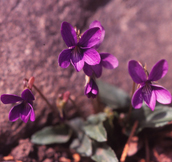
 Viola confusa ssp. nagasakiensis Violaceae
Viola confusa ssp. nagasakiensis Violaceae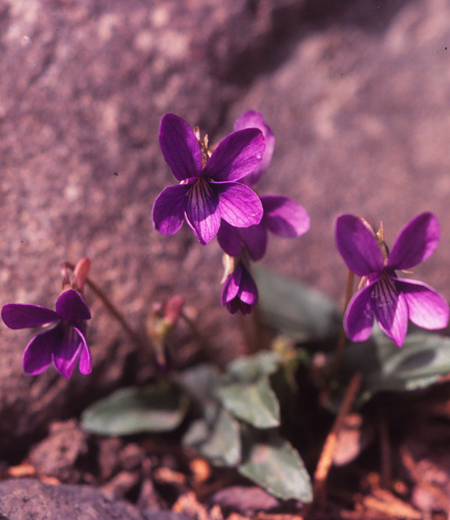 They are a perennial plant that grows at sunny places such as the roadside and between stonewalling around human habitations. (Perennial plant takes several years to grow). We seldom see them in the woods or around the forests. As the name implies it, they are one of the small Viola mandshurica and resemble Viola mandshurica (Violaceae), but they seem to be smaller by one size. Their characteristic to distinguish the two is the leafstalk (Youhei) of this species has no fins. The flower is about 1 to 1.5 cm in diameter, bluish-purple color, so that they stand out well from the others though small. The trichome grows at the root of the flower which blossom sideways. Tubular nectary or spur (Kyo: a portion of outpouchings behind the flower petal) is thin, about 4 mm long. The leaves are a thin and long triangular shape, and the root portion of the leaf is heart-shaped. Another characteristic is they have coarse sawtooth at the edge (Kyoshi: tooth-like rough part like a saw at the root of a leaf) and the back is tinged with purple.
They are a perennial plant that grows at sunny places such as the roadside and between stonewalling around human habitations. (Perennial plant takes several years to grow). We seldom see them in the woods or around the forests. As the name implies it, they are one of the small Viola mandshurica and resemble Viola mandshurica (Violaceae), but they seem to be smaller by one size. Their characteristic to distinguish the two is the leafstalk (Youhei) of this species has no fins. The flower is about 1 to 1.5 cm in diameter, bluish-purple color, so that they stand out well from the others though small. The trichome grows at the root of the flower which blossom sideways. Tubular nectary or spur (Kyo: a portion of outpouchings behind the flower petal) is thin, about 4 mm long. The leaves are a thin and long triangular shape, and the root portion of the leaf is heart-shaped. Another characteristic is they have coarse sawtooth at the edge (Kyoshi: tooth-like rough part like a saw at the root of a leaf) and the back is tinged with purple.
●Season Late March to about Mid April
●Height about 3 to 8 cm
●Place Minami-Takao -
Viola keiskei Violaceae
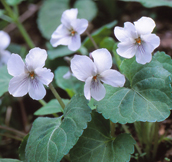
 Viola keiskei Violaceae
Viola keiskei Violaceae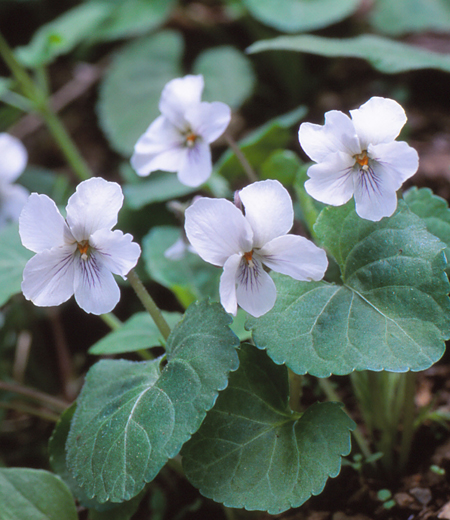 They are a perennial plant that grows at sunny places such as slanting surfaces or in the pool of the forest and the roadside along the mountain stream. (Perennial plant takes several years to grow). The shape of the leaves is rounded, which is the reason they are named ‘Viola keiskei’ (Marubasumire). As they resemble much Viola hondoensis which also have rounded leaves, the leaves of Viola keiskei (Marubasumire) have sharp tip that is nearly heart-shaped. This is how to distinguish the two. The flower is about 2 cm in diameter and the flower petals are also rounded. The trichome grows a little at the root of the flower which blossom sideways, mainly in white but some have the back of the flower petals in dark red color. In many cases, they grow in cluster and show up very well even during the blossom season. Tubular nectary or spur (Kyo: a portion of outpunching behind the flower petal) is about 6 to 7 mm long and has purple patterns. The leaves are about 2 to 4 cm long during the blossom season, but the summer leaves grow to be large about 7 to 8 cm long, and the plant height itself gets taller till about 30 cm.
They are a perennial plant that grows at sunny places such as slanting surfaces or in the pool of the forest and the roadside along the mountain stream. (Perennial plant takes several years to grow). The shape of the leaves is rounded, which is the reason they are named ‘Viola keiskei’ (Marubasumire). As they resemble much Viola hondoensis which also have rounded leaves, the leaves of Viola keiskei (Marubasumire) have sharp tip that is nearly heart-shaped. This is how to distinguish the two. The flower is about 2 cm in diameter and the flower petals are also rounded. The trichome grows a little at the root of the flower which blossom sideways, mainly in white but some have the back of the flower petals in dark red color. In many cases, they grow in cluster and show up very well even during the blossom season. Tubular nectary or spur (Kyo: a portion of outpunching behind the flower petal) is about 6 to 7 mm long and has purple patterns. The leaves are about 2 to 4 cm long during the blossom season, but the summer leaves grow to be large about 7 to 8 cm long, and the plant height itself gets taller till about 30 cm.
●Season Early March to about Late May
●Height about 5 to 10 cm
●Place Trail 3, Ura-Takao -
Polygala japonica Polygalaceae
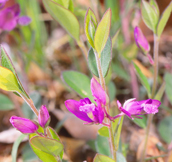
 Polygala japonica Polygalaceae
Polygala japonica Polygalaceae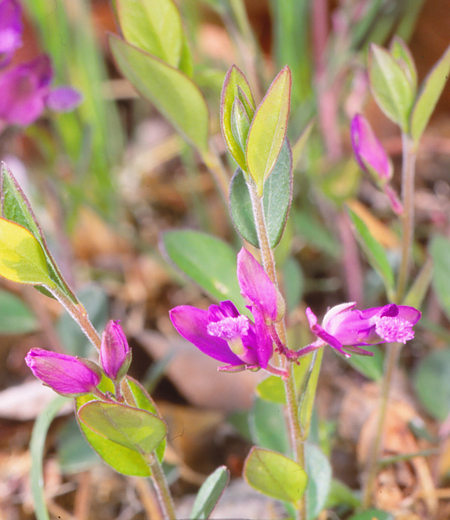 They are a perennial plant that grows at such arid places as at the sunny grasslands. (Perennial plant takes several years to grow). As the appearance of the flower looks like the one which is made as small as the flower of Lespedeza thunbergii (Fabaceae), this is how they are named ‘Polygala japonica’ (Himehagi). The flower is about 1 cm and tinged with red-purple color, a tubular shape flower composed of 3 flower petals, and the finely split bunch shoots to extend from the top.
They are a perennial plant that grows at such arid places as at the sunny grasslands. (Perennial plant takes several years to grow). As the appearance of the flower looks like the one which is made as small as the flower of Lespedeza thunbergii (Fabaceae), this is how they are named ‘Polygala japonica’ (Himehagi). The flower is about 1 cm and tinged with red-purple color, a tubular shape flower composed of 3 flower petals, and the finely split bunch shoots to extend from the top.
5 calyxes at the root portion of the flower is tinged with the same color with the flower petals, and 2 out of the five are open as if they are stretching the wings. When the flowers wither, he calyxes turn into green. The leaves are rounded egged-shaped with the sharp tip and trichome growing on both surfaces. The leaves during the flower season is about 1 centimeter long, they grow to be 3 cm long after the flower wither. Long white trichome develops on the stalk in cluster.
●Season Mid April to about Late May
●Height about 10 to 20 cm
●Place Mt.Inari, Ura-Takao, Minami-Takao -
Chrysosplenium album var. stamineum Saxifragaceae
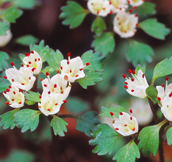
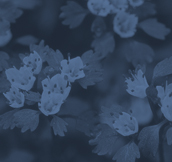 Chrysosplenium album var. stamineum Saxifragaceae
Chrysosplenium album var. stamineum Saxifragaceae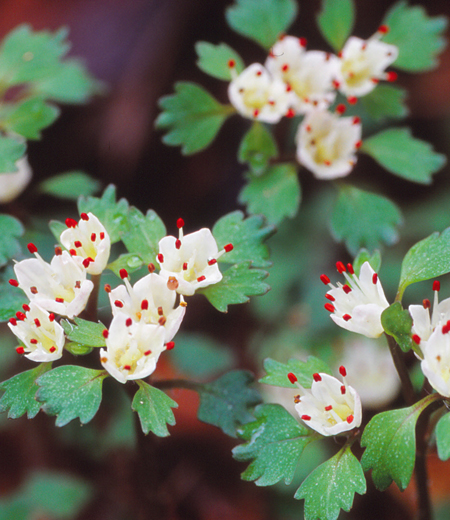 They are perennial plant that grows at humid pools of humid forest such as at rocky places along the mountain stream in mountain areas and (perennial plant takes several years to grow). Among the subdued flowers in the group of Chrysosplenium, their flowers are outstandingly beautiful, which is how they are named after. They bear a couple of small flowers about 5 mm in diameter at the top of straight stalk. With no actual flower petals, 4 white roundish calyxes are facing upward like flower petals, where 8 stamens with the top in red color come out from the inside, while white and red color contrast stands out remarkably. The leaves are roundish circular sector shape, about 5 to 8 mm long with dark green and edge-round obtuse sawtooth at the edge. After flowers wither, stalks begin to spread at the root to every direction. The stalk has sparse paraphyllium.
They are perennial plant that grows at humid pools of humid forest such as at rocky places along the mountain stream in mountain areas and (perennial plant takes several years to grow). Among the subdued flowers in the group of Chrysosplenium, their flowers are outstandingly beautiful, which is how they are named after. They bear a couple of small flowers about 5 mm in diameter at the top of straight stalk. With no actual flower petals, 4 white roundish calyxes are facing upward like flower petals, where 8 stamens with the top in red color come out from the inside, while white and red color contrast stands out remarkably. The leaves are roundish circular sector shape, about 5 to 8 mm long with dark green and edge-round obtuse sawtooth at the edge. After flowers wither, stalks begin to spread at the root to every direction. The stalk has sparse paraphyllium.
●Season Mid March to about Mid April
●Height about 5 to 10 cm
●Place Trail 1,Trail 6,Jyataki, Ura-Takao -
Saxifraga stolonifera Saxifragaceae
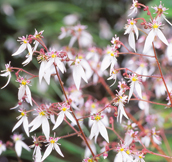
 Saxifraga stolonifera Saxifragaceae
Saxifraga stolonifera Saxifragaceae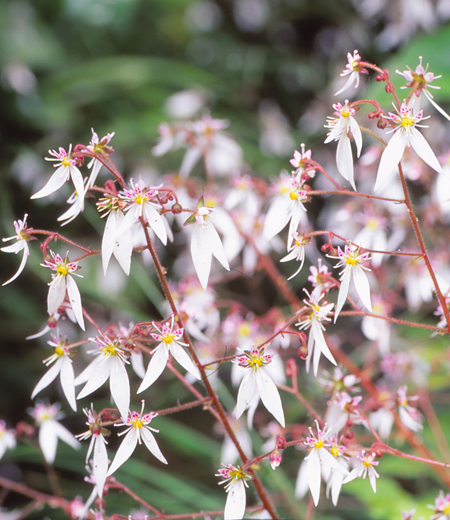 They are perennial plant that grows at humid places on rocks (perennial plant takes several years to grow). It is said the reason for their name is that their leaves remain green, not withered even under the snow in the midst of winter. Flowers have white 5 peals, of which 2 petals at down portion are about 1 to 2 cm long and dangling.
They are perennial plant that grows at humid places on rocks (perennial plant takes several years to grow). It is said the reason for their name is that their leaves remain green, not withered even under the snow in the midst of winter. Flowers have white 5 peals, of which 2 petals at down portion are about 1 to 2 cm long and dangling.
The rest of 3 are small and have dark red speckles. Flower stalk (Kakei: stem of flower bearing only flowers without leaves) has thin glandular trichome on it, where many flowers bloom into a cone form like decorations of Christmas tree. Leaves are 3 to 6 cm long, roundish kidney-shaped, and have a long stalk growing from the root. The surface of the leaf is dark green and has white patterns along the veins of leaves. The back surface is tinged with dark violet with lots of brown glandular trichome. Their characteristic of a leaf is thick and soft as well as folk remedy used effective for burn injury and eaten as edible wild plants.
●Season Late May to about Late June
●Height about 20 to 50 cm
●Place Trail 1,Trail 6, Jyataki,Oku-Takao -
Corydalis decumbens Papaveraceae
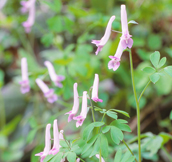
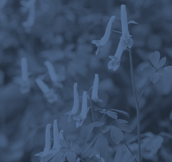 Corydalis decumbens Papaveraceae
Corydalis decumbens Papaveraceae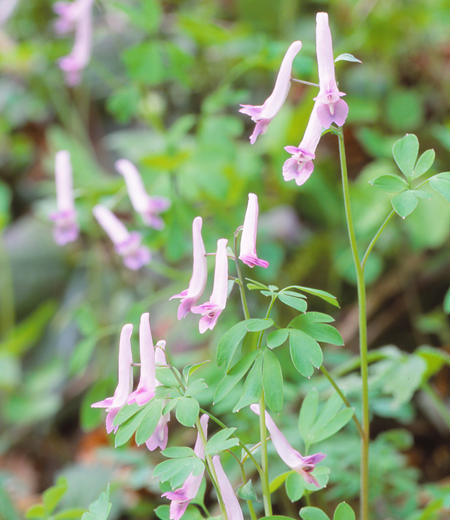 Perennial herbs found in bright forests and at forest edges in mountains and open fields. Similar to corydalis lineariloba, but this plant is easily identified with slightly thin flowers and untoothed bracts. The Japanese name Jirobo-engosaku was named because viola is called “Taro-bo” (the first son in the family) in Ise region, and this plants was named “Jiro-bo” (the second son in the family). This is because people used to call this flower with endearing feeling as children played by crossing elongated parts from corolla including spur and pulling to see which is strong. Flowers are tubular and 1..5 cm long. The color of flowers is red-purple to blue-purple and white in rare cases. Have several thin stems grow upright from a thick underground stem. Leaves on stems have patterns and in whorls of three and egg-shaped.
Perennial herbs found in bright forests and at forest edges in mountains and open fields. Similar to corydalis lineariloba, but this plant is easily identified with slightly thin flowers and untoothed bracts. The Japanese name Jirobo-engosaku was named because viola is called “Taro-bo” (the first son in the family) in Ise region, and this plants was named “Jiro-bo” (the second son in the family). This is because people used to call this flower with endearing feeling as children played by crossing elongated parts from corolla including spur and pulling to see which is strong. Flowers are tubular and 1..5 cm long. The color of flowers is red-purple to blue-purple and white in rare cases. Have several thin stems grow upright from a thick underground stem. Leaves on stems have patterns and in whorls of three and egg-shaped.
●Season Early April to about Late April
●Height about 10 to 20 cm
●Place Ura-Takao, Kita-Takao -
Corydalis pallida var. tenuis Papaveraceae
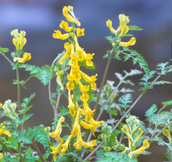
 Corydalis pallida var. tenuis Papaveraceae
Corydalis pallida var. tenuis Papaveraceae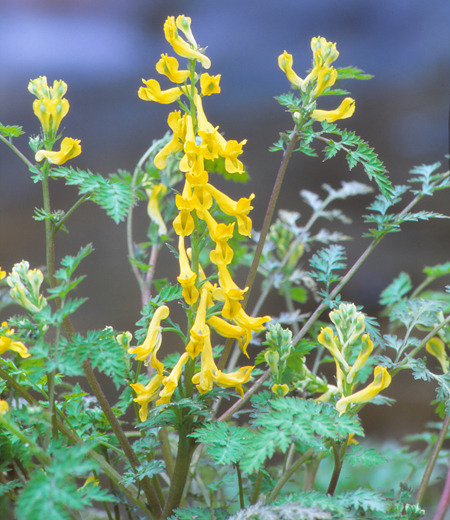 Biennial herbs found on sunny roadside, at forest edge and in deforested areas. The Japanese name is Miyama-ki-keman literally meaning deep in the mountain yellow flower wreath but this plant is also found in low elevations. Have many flowers on the tip of single stem that is appealing. This is the yellow version of corydalis incisa and also poisonous. In April, grow upright stem from the center of the plant and bloom many tubular flowers with two lips and about 2 cm long. Leaves vary from white powdered-like green to reddish green ones. Is soft texture with toothed margins and have unique rubber-like smell when it is rubbed. After flowering, bear 3 cm long beads-like fruits.
Biennial herbs found on sunny roadside, at forest edge and in deforested areas. The Japanese name is Miyama-ki-keman literally meaning deep in the mountain yellow flower wreath but this plant is also found in low elevations. Have many flowers on the tip of single stem that is appealing. This is the yellow version of corydalis incisa and also poisonous. In April, grow upright stem from the center of the plant and bloom many tubular flowers with two lips and about 2 cm long. Leaves vary from white powdered-like green to reddish green ones. Is soft texture with toothed margins and have unique rubber-like smell when it is rubbed. After flowering, bear 3 cm long beads-like fruits.
●Season Early April to about Mid May
●Height about 20 to 40 cm
●Place Trail 1 to 3, Trail 5, Jyataki, Ura-Takao, Oku-Takao -
Corydalis incisa Papaveraceae
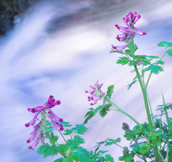
 Corydalis incisa Papaveraceae
Corydalis incisa Papaveraceae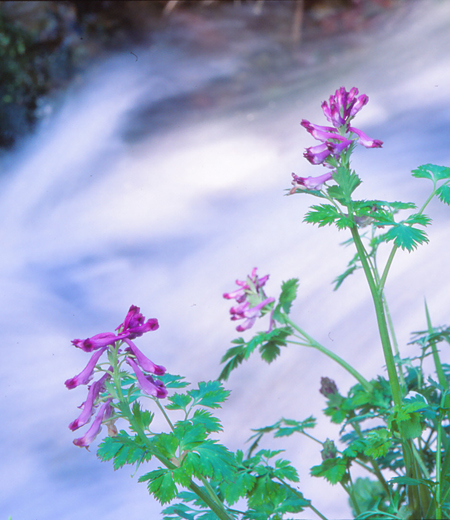 Biennial herbs found on bright forest floor and at forest edges in mountains and also in flatlands. The Japanese name is Murasaki-keman was named after the flower resembles keman which is the flower wreath decorated on Buddhist alter. The entire plant is soft but emit bad odor when scratched. Radical leaves grow covering ground and spent winter. In spring, stem grows upright and bloom many flowers about 1..5 cm long. Color of flowers is red-purple and similar to corydalis lineariloba and corydalis decumbens but this plant has finely toothed leaves like the leaves of carrots. The entire plants are poisonous and cause vomiting when eaten by mistake. In Mt. Takao, caterpillars of Japanese clouded apollo feed on leaves of this plant.
Biennial herbs found on bright forest floor and at forest edges in mountains and also in flatlands. The Japanese name is Murasaki-keman was named after the flower resembles keman which is the flower wreath decorated on Buddhist alter. The entire plant is soft but emit bad odor when scratched. Radical leaves grow covering ground and spent winter. In spring, stem grows upright and bloom many flowers about 1..5 cm long. Color of flowers is red-purple and similar to corydalis lineariloba and corydalis decumbens but this plant has finely toothed leaves like the leaves of carrots. The entire plants are poisonous and cause vomiting when eaten by mistake. In Mt. Takao, caterpillars of Japanese clouded apollo feed on leaves of this plant.
●Season Early April to about Mid May
●Height about20 to 50 cm
●Place Trail 1, Trail 3, Mt. Inari, Ura-Takao, Oku-Takao, Minami-Takao -
Corydalis lineariloba Papaveraceae
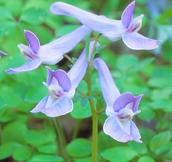
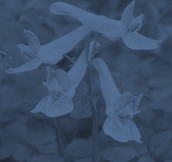 Corydalis lineariloba Papaveraceae
Corydalis lineariloba Papaveraceae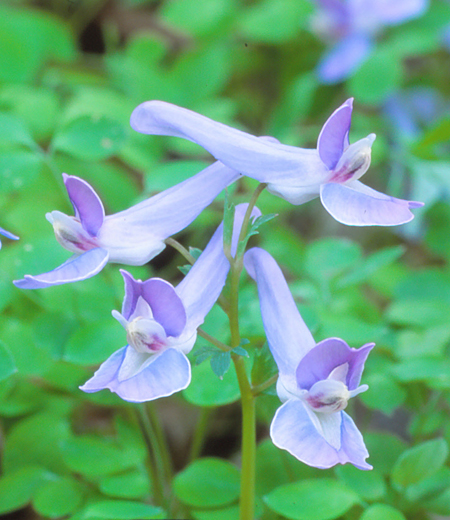 Perennial herbs (grow for several years from their same root system) found at bright forest edges and in forests in mountains fields. In Mt. Takao, found in wet areas including streamside. Bloom pointed hat-like shaped flowers in early spring. Flowers are 2 cm long, red-purple to blue-purple. Become more bluish at higher elevations or northern area. Bracts (variants of leaves at the base of petals) are lobed but similar corydalis decumbens are not. This is where to identify this plant. Leaves are ternate compound leaves, three leaves as one set grow from long petioles. The shape of leaves are like foot of birds and pinnate in three. Small underground stems are used as herbal medicine called Engosaku to ease pain or cramps.
Perennial herbs (grow for several years from their same root system) found at bright forest edges and in forests in mountains fields. In Mt. Takao, found in wet areas including streamside. Bloom pointed hat-like shaped flowers in early spring. Flowers are 2 cm long, red-purple to blue-purple. Become more bluish at higher elevations or northern area. Bracts (variants of leaves at the base of petals) are lobed but similar corydalis decumbens are not. This is where to identify this plant. Leaves are ternate compound leaves, three leaves as one set grow from long petioles. The shape of leaves are like foot of birds and pinnate in three. Small underground stems are used as herbal medicine called Engosaku to ease pain or cramps.
●Season Late March to Mid April
●Height about 10 to 20 cm
●Place Ura-Takao, Kita-Takao -
Anemone raddeana Ranunculaceae
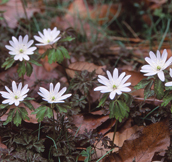
 Anemone raddeana Ranunculaceae
Anemone raddeana Ranunculaceae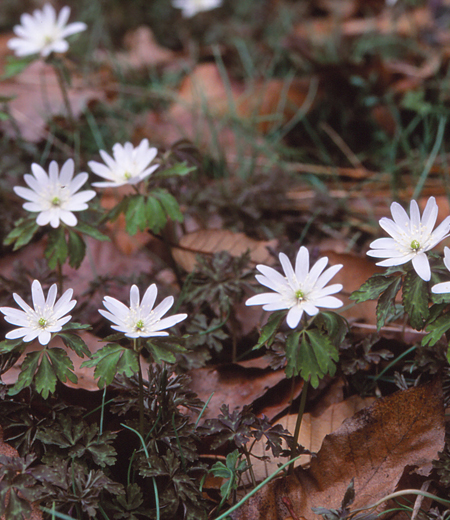 Perennial herbs (grow for several years from their same root system) found in bright forests and grasslands in mountains in early spring. One of the plants indicates the coming of spring and often found at forest edges of deciduous forests along streams. Flowers are 3 to 4 cm in diameter. One white flower blooms at the tip of a stem. The Japanese name Azuma-ichi-ge literally meaning one flower in east area was named because many of them grow in Kanto region and bloom only one flower. Leaves are trifoliate compound leaves and have three small flowers as one set. The size of leaves is 2 to 3 cm long with round edges, soft texture and dropping. Similar to anemone pseudo-altaica but the leaves of this plant have toothed margins.
Perennial herbs (grow for several years from their same root system) found in bright forests and grasslands in mountains in early spring. One of the plants indicates the coming of spring and often found at forest edges of deciduous forests along streams. Flowers are 3 to 4 cm in diameter. One white flower blooms at the tip of a stem. The Japanese name Azuma-ichi-ge literally meaning one flower in east area was named because many of them grow in Kanto region and bloom only one flower. Leaves are trifoliate compound leaves and have three small flowers as one set. The size of leaves is 2 to 3 cm long with round edges, soft texture and dropping. Similar to anemone pseudo-altaica but the leaves of this plant have toothed margins.
●Season Late March to Late April
●Height about 10 to 15 cm
●Place Ura-Takao, Minami-Takao -
Anemone nikoensis Ranunculaceae
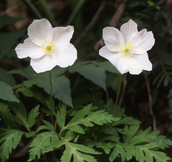
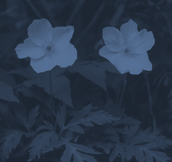 Anemone nikoensis Ranunculaceae
Anemone nikoensis Ranunculaceae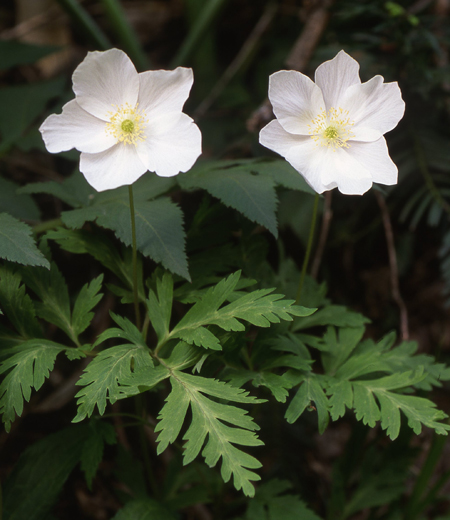 Perennial herbs (grow for several years from their same root system) found in wet areas including bright forest edges, grasslands along streamside in mountains. The Japanese name Ichirin-so literally meaning one flower on a stem was named because it only blooms one large flower on the top of a stem. In rare cases, bloom two flowers that may look like anemone flaccid. The point to identify this plant is leaves are finely lobed and flowers are large. Flowers are 4 cm in diameter and very appealing with five to six sepals like petals. Most of them are white but some are light purple on the back, hence another name Ura-beni-ichige literally meaning one flower with red on the back. Three leaves on long petioles grow from the middle of stems. Leaves are deeply lobed like serrated edge.
Perennial herbs (grow for several years from their same root system) found in wet areas including bright forest edges, grasslands along streamside in mountains. The Japanese name Ichirin-so literally meaning one flower on a stem was named because it only blooms one large flower on the top of a stem. In rare cases, bloom two flowers that may look like anemone flaccid. The point to identify this plant is leaves are finely lobed and flowers are large. Flowers are 4 cm in diameter and very appealing with five to six sepals like petals. Most of them are white but some are light purple on the back, hence another name Ura-beni-ichige literally meaning one flower with red on the back. Three leaves on long petioles grow from the middle of stems. Leaves are deeply lobed like serrated edge.
●Season Mid April to Mid May
●Height about 15 to 20 cm
●Place Ura-Takao, Minami-Takao -
Dichocarpum trachyspermum Ranunculaceae
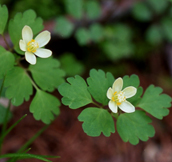
 Dichocarpum trachyspermum Ranunculaceae
Dichocarpum trachyspermum Ranunculaceae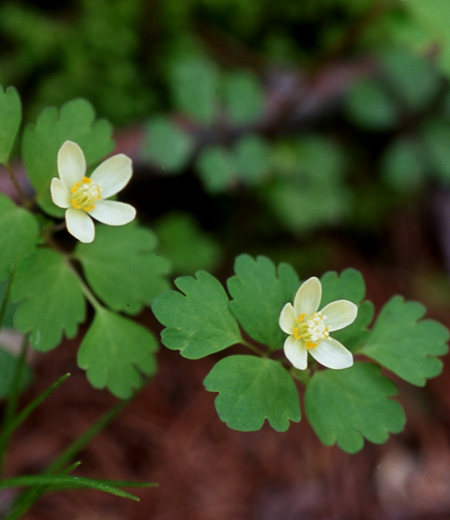 Perennial herbs (grow for several years from their same root system) found in wet areas including streamside, roadside and forest edges in mountains. Have a soft impression without hair. After flowering, bloom two opposite elongated green fruits. This look like the tails of mackerel and many grow in Kanto region, hence the Japanese name Tougoku-sabanoo literally meaning tail of mackerel in the east. Flowers are 6 to 8 mm in diameters and light cream color. Have yellow petals like sumo referee’s fan inside of sepals looks like flower petals. Leaves are light green and radical leaves (leaves grow from the roots) near the root. Stems have three to five leaves alternate. The shape of leaves is like fans with toothed margins (edges of leaves are like a teeth of saw). Bloom cleistogamous flowers (never open and self-pollinating) at the base of a stem in summer.
Perennial herbs (grow for several years from their same root system) found in wet areas including streamside, roadside and forest edges in mountains. Have a soft impression without hair. After flowering, bloom two opposite elongated green fruits. This look like the tails of mackerel and many grow in Kanto region, hence the Japanese name Tougoku-sabanoo literally meaning tail of mackerel in the east. Flowers are 6 to 8 mm in diameters and light cream color. Have yellow petals like sumo referee’s fan inside of sepals looks like flower petals. Leaves are light green and radical leaves (leaves grow from the roots) near the root. Stems have three to five leaves alternate. The shape of leaves is like fans with toothed margins (edges of leaves are like a teeth of saw). Bloom cleistogamous flowers (never open and self-pollinating) at the base of a stem in summer.
●Season Early April to Early May
●Height about 10 to 15 cm
●Place Ura-Takao, Minami-Takao -
Anemone flaccida Ranunculaceae
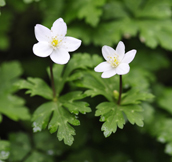
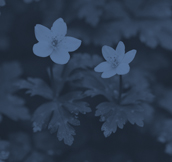 Anemone flaccida Ranunculaceae
Anemone flaccida Ranunculaceae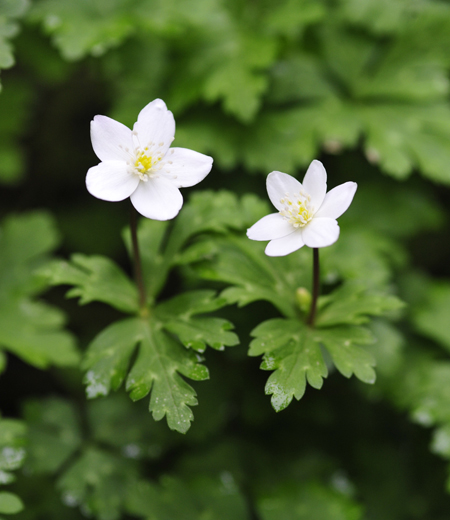 Perennial herbs (grow for several years from their same root system) found in sunny forest edge, forests and grasslands along streams in mountains. Bloom two flowers on a stem, hence the Japanese name Nirin-so literally meaning two flowers plants. In reality, many bloom only one or even three flowers. Prefer wet areas and often seen them in forests near waterside. It is very beautiful that the ground is covered with white flowers. Flowers are 2 cm in diameter and bloom on top of two flower stalks. Compare to anemone nikoensis, flowers look a lot smaller. Have five sepals look like petals which is mainly white but also have light red or green colored. Some have seven sepals. In the middle of a stem, three leaves grow without petioles.
Perennial herbs (grow for several years from their same root system) found in sunny forest edge, forests and grasslands along streams in mountains. Bloom two flowers on a stem, hence the Japanese name Nirin-so literally meaning two flowers plants. In reality, many bloom only one or even three flowers. Prefer wet areas and often seen them in forests near waterside. It is very beautiful that the ground is covered with white flowers. Flowers are 2 cm in diameter and bloom on top of two flower stalks. Compare to anemone nikoensis, flowers look a lot smaller. Have five sepals look like petals which is mainly white but also have light red or green colored. Some have seven sepals. In the middle of a stem, three leaves grow without petioles.
●Season Early April to Early May
●Height about 15 to 20 cm
●Place Trail 1, Trail 6, Jyataki, Ura-Takao, Oku-Takao, Minami-Takao, Kita-Takao -
Stellaria sessiliflora Caryophyllaceae
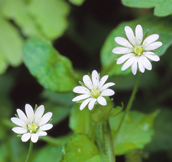
 Stellaria sessiliflora Caryophyllaceae
Stellaria sessiliflora Caryophyllaceae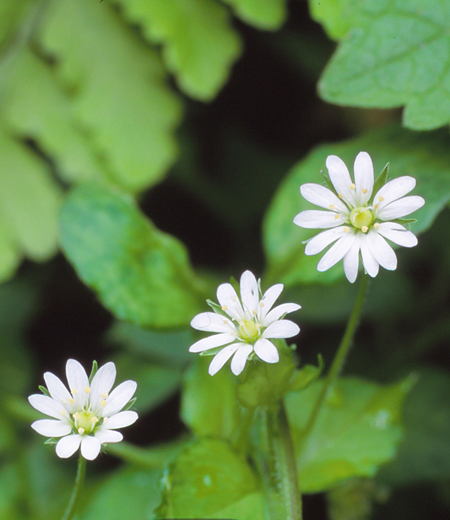 They are a perennial plant that thrive in humid shady places such sunny as in the pool of the forests, in the forests, and on the forest roads along the mountain streams (Perennial plant takes several years to grow). Their species have a very large flower among the group of Stellaria media. The white flower blossoms out upwards, thus, they distinguish themselves. One flower is about 1 to 1.5 cm in diameter on the stalk growing from the root of the leaf. They bear 5 flower petals, and each of them is split into 2, which makes them have 10 of flower petals. Sepal attached at the base of the flowers is sharp and a long white trichome grows outside. The leaf is wide egged-shaped like a spade, about 1 to 3.5 cm long, with the back carrying vellus along the leaf veins. The leaf grown from the bottom of the stalk has a long stem. Their characteristic is the stalk has usually 2 lines of trichome, which expands widespread like creeping on the ground.
They are a perennial plant that thrive in humid shady places such sunny as in the pool of the forests, in the forests, and on the forest roads along the mountain streams (Perennial plant takes several years to grow). Their species have a very large flower among the group of Stellaria media. The white flower blossoms out upwards, thus, they distinguish themselves. One flower is about 1 to 1.5 cm in diameter on the stalk growing from the root of the leaf. They bear 5 flower petals, and each of them is split into 2, which makes them have 10 of flower petals. Sepal attached at the base of the flowers is sharp and a long white trichome grows outside. The leaf is wide egged-shaped like a spade, about 1 to 3.5 cm long, with the back carrying vellus along the leaf veins. The leaf grown from the bottom of the stalk has a long stem. Their characteristic is the stalk has usually 2 lines of trichome, which expands widespread like creeping on the ground.
●Season Late April to about Late June
●Height about 20 to 30 cm
●Place Ura-Takao -
Elatostema umbellatum var. majus Urticaceae
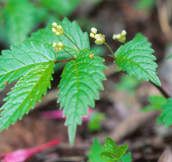
 Elatostema umbellatum var. majus Urticaceae
Elatostema umbellatum var. majus Urticaceae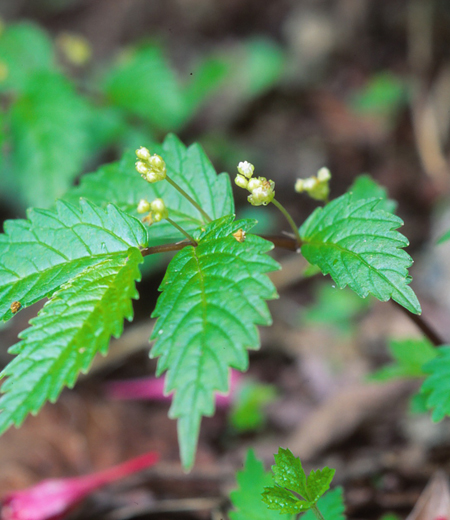 Perennial herbs (grow for several years from their same root system) found in wet areas including streamside, roadside and slopes. The Japanese name Uwabami-so literally meaning large sized snake plant was named because many of them grow in the areas where large snake lives. Is also often called as Mizu or Mizuna literally meaning water or water plants because it contains a lot of moisture. Stems are reddish with asymmetric leaf. Leaves are 4 to 10 cm long, oval-shaped with toothed margins (edges of leaves are like a teeth of saw) and have hairs on both sides. Bloom small flowers in clusters on a peduncle grow from a petiole. In autumn, sprout become round-shaped with nutrients called Mukago (bulblet).
Perennial herbs (grow for several years from their same root system) found in wet areas including streamside, roadside and slopes. The Japanese name Uwabami-so literally meaning large sized snake plant was named because many of them grow in the areas where large snake lives. Is also often called as Mizu or Mizuna literally meaning water or water plants because it contains a lot of moisture. Stems are reddish with asymmetric leaf. Leaves are 4 to 10 cm long, oval-shaped with toothed margins (edges of leaves are like a teeth of saw) and have hairs on both sides. Bloom small flowers in clusters on a peduncle grow from a petiole. In autumn, sprout become round-shaped with nutrients called Mukago (bulblet).
●Season Late April to Early June
●Height about 20 to 30 cm
●Place Trail 1, Trail 3 and 4, Trail 6, Ura-Takao, Oku-Takao -
Chloranthus japonicus Chloranthaceae
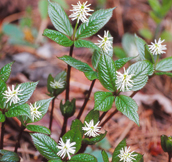
 Chloranthus japonicus Chloranthaceae
Chloranthus japonicus Chloranthaceae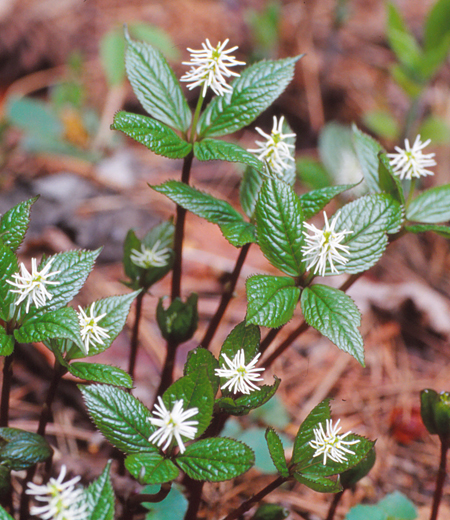 They are a perennial plant that grows at such places as under the forests or at the grasslands at the base of a mountain district and on the mountain. (Perennial plant takes several years to grow). 4 leaves grow on the stalk like covering the stalk and 1 white inflorescence (Kajo: arrangement of flowers on a stalk) stands still from the center. The name derivation of ‘Chloranthus japonicus’ (Hitori-Shizuka) comes from their elegant appearance which is compared as courtly Shizukagozen (one of the most famous women in Japanese history court dancer of the 12th century). The inflorescence is about 3 cm long and like white brush. Their characteristic is the white potion of inflorescence is a male stamen and they don’t have the flower petals or calyx. The stalk grows upstraight. When it begins to grow, it is tinged with dark green with a sharp sawtooth at the edge (Kyoshi: tooth-like rough part like a saw at the root of a leaf) at the edge. When the flowers wither, they bear the rounded seeds about 2.3 to 3 mm in diameter.
They are a perennial plant that grows at such places as under the forests or at the grasslands at the base of a mountain district and on the mountain. (Perennial plant takes several years to grow). 4 leaves grow on the stalk like covering the stalk and 1 white inflorescence (Kajo: arrangement of flowers on a stalk) stands still from the center. The name derivation of ‘Chloranthus japonicus’ (Hitori-Shizuka) comes from their elegant appearance which is compared as courtly Shizukagozen (one of the most famous women in Japanese history court dancer of the 12th century). The inflorescence is about 3 cm long and like white brush. Their characteristic is the white potion of inflorescence is a male stamen and they don’t have the flower petals or calyx. The stalk grows upstraight. When it begins to grow, it is tinged with dark green with a sharp sawtooth at the edge (Kyoshi: tooth-like rough part like a saw at the root of a leaf) at the edge. When the flowers wither, they bear the rounded seeds about 2.3 to 3 mm in diameter.
●Season Early April to about Early May
●Height about 10 to 15 cm
●Place Ura-Takao, Oku-Takao ,Minami-Takao -
Calanthe discolor Orchidaceae
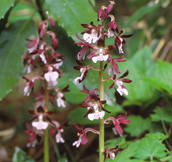
 Calanthe discolor Orchidaceae
Calanthe discolor Orchidaceae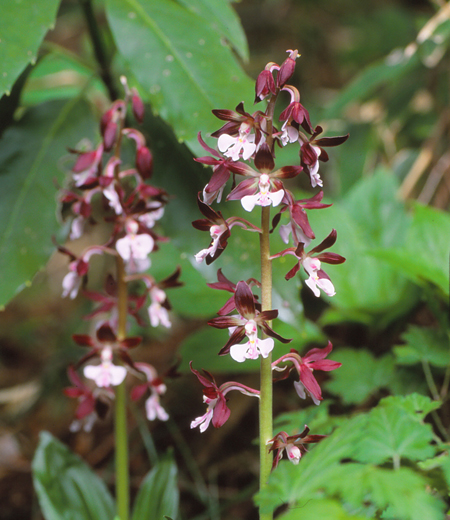 They are perennial plant that grows in the cops and bamboo thickets (perennial plant takes several years to grow).10 to 20 flowers bloom a bit among them at the top of straight stalk. The number is decreasing due to illegally digging up plants for gardening. The underground stem has rounded knots extended in a row, which resembles stooping shrimps. This is how they are named ‘Calanthe discolor’ (Ebine). The flower is about 2 to 3 cm in diameter with three flower petals and three sepals. Flower petals on the bottom are divided widely and usually pale red or white. Though flower petals and sepals are olive-brown, there is a large individual variation. Radical leaf (Konseiyou: eaves springing up at the root of the stem) is an elliptical shape about 10 to 30 cm long, 5 to 8 cm wide. 3 to 5 of radical leaf grow from the root and come up like wrapping up the stalk. Leaves remain still there even in winter, but when it is time to bloom and new leaves sprout, the older ones wither.
They are perennial plant that grows in the cops and bamboo thickets (perennial plant takes several years to grow).10 to 20 flowers bloom a bit among them at the top of straight stalk. The number is decreasing due to illegally digging up plants for gardening. The underground stem has rounded knots extended in a row, which resembles stooping shrimps. This is how they are named ‘Calanthe discolor’ (Ebine). The flower is about 2 to 3 cm in diameter with three flower petals and three sepals. Flower petals on the bottom are divided widely and usually pale red or white. Though flower petals and sepals are olive-brown, there is a large individual variation. Radical leaf (Konseiyou: eaves springing up at the root of the stem) is an elliptical shape about 10 to 30 cm long, 5 to 8 cm wide. 3 to 5 of radical leaf grow from the root and come up like wrapping up the stalk. Leaves remain still there even in winter, but when it is time to bloom and new leaves sprout, the older ones wither.
●Season Mid April to about Mid May
●Height about 30 to 40 cm
●Place Oku-Takao -
Cephalanthera falcate Orchidaceae
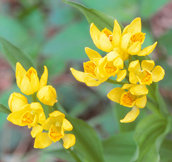
 Cephalanthera falcate Orchidaceae
Cephalanthera falcate Orchidaceae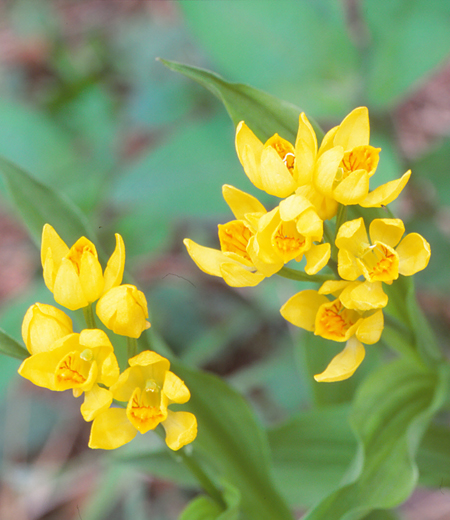 They are perennial plant that grows in the sunny copse of mountain districts and hills (perennial plant takes several years to grow). As the number of mountain districts are decreasing, so are they, thus they are one of rare orchids that we can see at Mt. Takao. They bear brilliant yellow flowers and this is why they are named ‘Cephalanthera falcata’. The flower is 1 to 1.5 cm in diameter. 3 to 12 flowers bloom a bit upward at the top of stalk. Few of flowers are fully open while most of them are half-open. The flower petal and calyx are almost same in color. The bottommost flower petal is tubulous at the root and inside has 5 to 7 dark brown projections called ‘ridge’. The leaf looks like bamboo grass, is about 8 to 15 cm long and 2 to 4.5 cm wide, has longitudinal wrinkles, and grows alternate as if they are wrapping the stalk. The underground stem spreads deep inside of the ground.
They are perennial plant that grows in the sunny copse of mountain districts and hills (perennial plant takes several years to grow). As the number of mountain districts are decreasing, so are they, thus they are one of rare orchids that we can see at Mt. Takao. They bear brilliant yellow flowers and this is why they are named ‘Cephalanthera falcata’. The flower is 1 to 1.5 cm in diameter. 3 to 12 flowers bloom a bit upward at the top of stalk. Few of flowers are fully open while most of them are half-open. The flower petal and calyx are almost same in color. The bottommost flower petal is tubulous at the root and inside has 5 to 7 dark brown projections called ‘ridge’. The leaf looks like bamboo grass, is about 8 to 15 cm long and 2 to 4.5 cm wide, has longitudinal wrinkles, and grows alternate as if they are wrapping the stalk. The underground stem spreads deep inside of the ground.
●Season Late April to about Late May
●Height about 30 to 60 cm
●Place Ura-Takao,Oku-Takao -
Cymbidium goeringii(Riverstream orchid) Orchidaceae
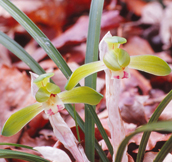
 Cymbidium goeringii(Riverstream orchid) Orchidaceae
Cymbidium goeringii(Riverstream orchid) Orchidaceae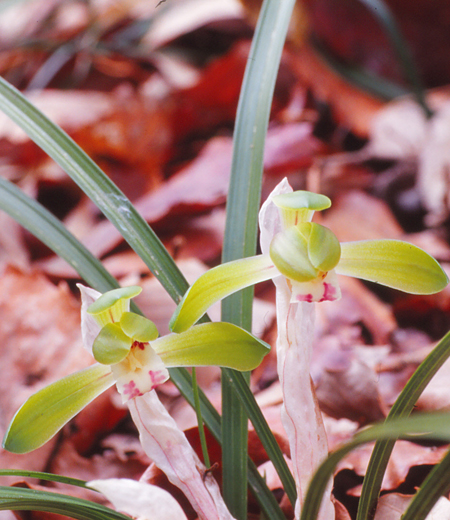 They are perennial plant that grows in the sunny and arid copse (perennial plant takes several years to grow). This is also one of the rare, decreasing species at Mt. Takao. As Chinese name ‘Syun-ran’ shows it, they are earliest in the bloom in the spring among the group of Orchidaceae. The flower is 3 to 3.5 cm in diameter and usually bloom at the top of flower stalk (Kakei: stalk that can have flowers without leaves). The side-valve and calyx of the flower are yellow-green. The bottommost flower petal has pattern mottles of blood red, which resemble face mole or mottled face. This is why they are also called ‘dark mole’ or ‘JiJi-BaBa’ (Aged people or grandfather/grandmother) . Flower stalk is covered with the transparent scale leaf (Rinpen: transformed leaf into scale-like) and chylocaulous and thick. The leaf is thin about 20 to 35 cm long and 0.6 to 1 cm wide. Leaves are hard and rough to touch with sawtooth at the edge. Lots of green leaves sprout from the root all year round so well that they stand out nice even early in the spring.
They are perennial plant that grows in the sunny and arid copse (perennial plant takes several years to grow). This is also one of the rare, decreasing species at Mt. Takao. As Chinese name ‘Syun-ran’ shows it, they are earliest in the bloom in the spring among the group of Orchidaceae. The flower is 3 to 3.5 cm in diameter and usually bloom at the top of flower stalk (Kakei: stalk that can have flowers without leaves). The side-valve and calyx of the flower are yellow-green. The bottommost flower petal has pattern mottles of blood red, which resemble face mole or mottled face. This is why they are also called ‘dark mole’ or ‘JiJi-BaBa’ (Aged people or grandfather/grandmother) . Flower stalk is covered with the transparent scale leaf (Rinpen: transformed leaf into scale-like) and chylocaulous and thick. The leaf is thin about 20 to 35 cm long and 0.6 to 1 cm wide. Leaves are hard and rough to touch with sawtooth at the edge. Lots of green leaves sprout from the root all year round so well that they stand out nice even early in the spring.
●Season Late March to about Late April
●Height about 15 to 25 cm
●Place Trail 5, Mt.Inari, Ura-Takao, Oku-Takao, Minami-Takao -
Iris japonica Iridaceae
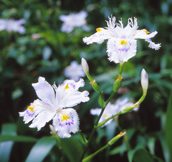
 Iris japonica Iridaceae
Iris japonica Iridaceae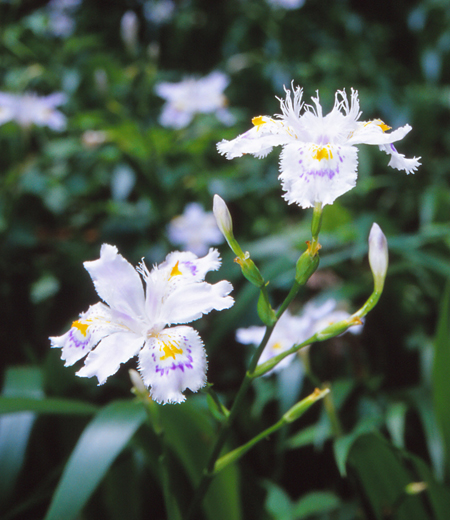 Perennial evergreen herbs (grow for several years from their same root system) found at streamside, in forests and forest edges from the foot of mountains to a mountain peak. Grow by extending rhizomes because they are unable to produce seeds. Taking advantage of this characteristic, often planted as a retaining wall on riverbank. Flowers are 4 to 6 cm in diameter, bloom in the morning and wither in late afternoon. Are finely lobed on edges and light purple with purple and orange patterns on outer petals are beautiful. Blooming season is long and blooming in clumps is striking. Often find the clusters in many places in Mt. Takao. Leaves are sword-shaped, 30 to 60 cm long, shiny surface and bright green.
Perennial evergreen herbs (grow for several years from their same root system) found at streamside, in forests and forest edges from the foot of mountains to a mountain peak. Grow by extending rhizomes because they are unable to produce seeds. Taking advantage of this characteristic, often planted as a retaining wall on riverbank. Flowers are 4 to 6 cm in diameter, bloom in the morning and wither in late afternoon. Are finely lobed on edges and light purple with purple and orange patterns on outer petals are beautiful. Blooming season is long and blooming in clumps is striking. Often find the clusters in many places in Mt. Takao. Leaves are sword-shaped, 30 to 60 cm long, shiny surface and bright green.
●Season Mid April to Late May
●Height about 50 to 60 cm
●Place Trail 1 to 6, Mt. Inari, Jyataki, Ura-Takao, Iroha ,Oku-Takao -
Arisaema urashima Araceae
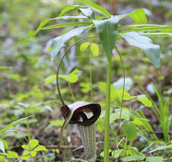
 Arisaema urashima Araceae
Arisaema urashima Araceae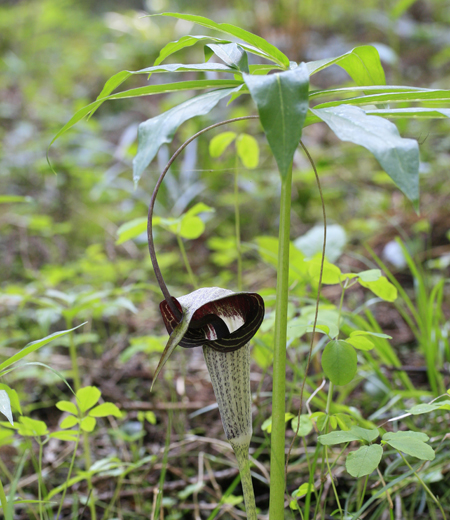 Perennial herbs found in wood shades from flatlands to low elevations. The dark-purple spathe is on peduncle grows from petiole. Is a dioecious flower, male when it is young and change to female with age. The long spadix of flowers grow from spathe is like a whip. This is like Taro Urashima (the main character of the fairy-tale in Japan, Urashima Taro) holding the fishing rod. Petioles grow upright about 50 cm like a thick stem. Have eleven to seventeen leaves grow per petioles and open like the foot of birds. Have poisonous ingredients like saponin in plants and cause mouth burn-like pain when eaten by mistake.
Perennial herbs found in wood shades from flatlands to low elevations. The dark-purple spathe is on peduncle grows from petiole. Is a dioecious flower, male when it is young and change to female with age. The long spadix of flowers grow from spathe is like a whip. This is like Taro Urashima (the main character of the fairy-tale in Japan, Urashima Taro) holding the fishing rod. Petioles grow upright about 50 cm like a thick stem. Have eleven to seventeen leaves grow per petioles and open like the foot of birds. Have poisonous ingredients like saponin in plants and cause mouth burn-like pain when eaten by mistake.
●Season Mid April to about Late May
●Height about 40 to 60 cm
●Place Ura-Takao -
Syneilesis palmate (Shredded Umbrella Plant) Compositae
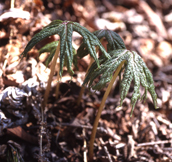
 Syneilesis palmate (Shredded Umbrella Plant) Compositae
Syneilesis palmate (Shredded Umbrella Plant) Compositae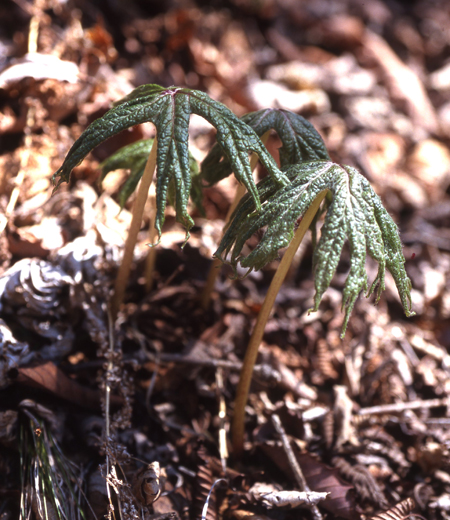 Perennial herbs found on hills and in mountain forests. Japanese name Yaburegasa literally meaning shredded umbrella plants was named because its young leaves sprouted from the ground around mid-April resemble half-open shredded umbrella. At first, an upright flower stalk grows from one radical leaf and blooms about 1 cm in diameter flower. Flowers are flower heads and white or pale red. Bloom seven to thirteen five-lobed tubular flowers and protruding stamens are appealing. Leaves are round-shaped, about 35 to 50 cm in diameter and distinctly lobed like the palm with long stalks. Young leaves have cotton hair and it disappear as it grows. Young leaves are edible, boiled leaves can be marinated, vinegared or used for soup, and fresh leaves for deep fried tempura.
Perennial herbs found on hills and in mountain forests. Japanese name Yaburegasa literally meaning shredded umbrella plants was named because its young leaves sprouted from the ground around mid-April resemble half-open shredded umbrella. At first, an upright flower stalk grows from one radical leaf and blooms about 1 cm in diameter flower. Flowers are flower heads and white or pale red. Bloom seven to thirteen five-lobed tubular flowers and protruding stamens are appealing. Leaves are round-shaped, about 35 to 50 cm in diameter and distinctly lobed like the palm with long stalks. Young leaves have cotton hair and it disappear as it grows. Young leaves are edible, boiled leaves can be marinated, vinegared or used for soup, and fresh leaves for deep fried tempura.
●Season Late June to about Mid-October
●Height about 50 cm to 1 m
●Place Trail 1, Trail 3 to 5, Ura-Takao, Kita-Takao -
Campanula punctata ( Spotted Bellflower) Campanulaceae
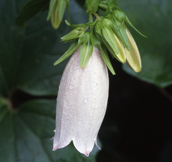
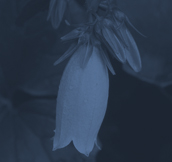 Campanula punctata ( Spotted Bellflower) Campanulaceae
Campanula punctata ( Spotted Bellflower) Campanulaceae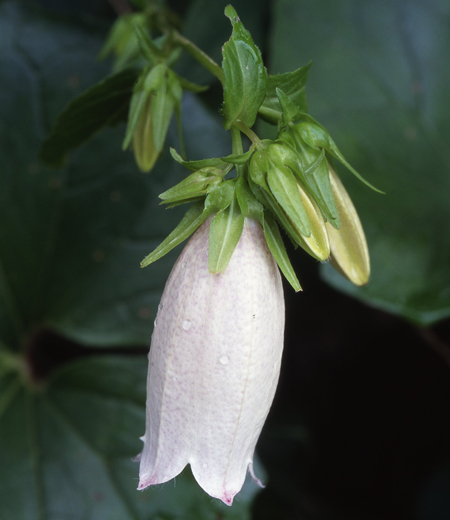 Perennial herbs found in dry mountainous grassland or on roadside. Have hair on its full body and grow with a prostrate stem from each node. Japanese name Hotaru-Bukuro literally meaning firefly’s bag because flowers are paper lantern-shaped and children played fireflies inside of the flowers. Flowers are about about 4 to 5 cm long, tubular and dropping bell-shaped, and white, purple and light red. Five-lobed petals are with recurved appendages between calyx. Similar flowers, campanula punctata lam. var. hondoensis (kitam.) ohwi are without these appendages. Leaves are about 5 to 7 cm long, oval-shaped with pointed tip and toothed margins. Radical leaves are heart-shaped and die when blooming season start.
Perennial herbs found in dry mountainous grassland or on roadside. Have hair on its full body and grow with a prostrate stem from each node. Japanese name Hotaru-Bukuro literally meaning firefly’s bag because flowers are paper lantern-shaped and children played fireflies inside of the flowers. Flowers are about about 4 to 5 cm long, tubular and dropping bell-shaped, and white, purple and light red. Five-lobed petals are with recurved appendages between calyx. Similar flowers, campanula punctata lam. var. hondoensis (kitam.) ohwi are without these appendages. Leaves are about 5 to 7 cm long, oval-shaped with pointed tip and toothed margins. Radical leaves are heart-shaped and die when blooming season start.
●Season Mid-June to about Late July
●Height about 30 to 80 cm
●Place Trail 1, Trail 5, Mt. Inari, Jyataki, Ura-Takao, Oku-Takao,
Minami-Takao -
Patrinia villosa Valerianaceae
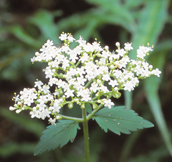
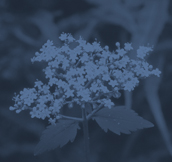 Patrinia villosa Valerianaceae
Patrinia villosa Valerianaceae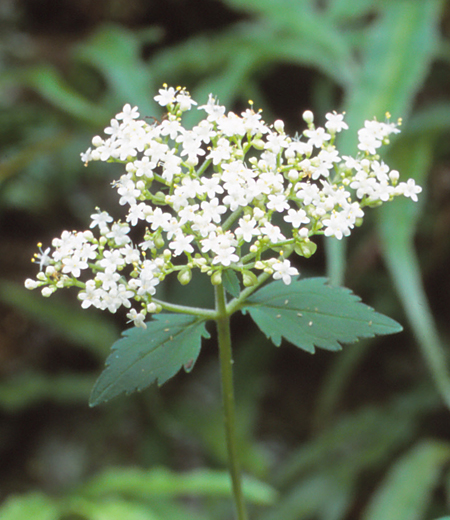 Perennial herbs found on sunny hills and fields. Are runner plants and produce numerous runners to reproduce new plants. Japanese name, Otokoeshi literally meaning masculine flower is named to differentiate them from Ominaeshi (patrinia scabiosifolia) literally meaning feminine flower with yellow flowers because Otokoeshi’s stems and leaves are large and looks strong and tough masculine image even though its flowers are white and simple. Flowers are about 4 mm in diameter and bloom on the tip of branches. Leaves are oval-shape and about 3 to 15 cm long and stem leaves are pinnately parted. Stems at the base have rough white hair. After flowering, bears oval and about 3 mm long fruits. Fruits has round-shaped wings and can be flown by the wind when ripe. Roots are used as Chinese medicine for its anti-inflammatory effects.
Perennial herbs found on sunny hills and fields. Are runner plants and produce numerous runners to reproduce new plants. Japanese name, Otokoeshi literally meaning masculine flower is named to differentiate them from Ominaeshi (patrinia scabiosifolia) literally meaning feminine flower with yellow flowers because Otokoeshi’s stems and leaves are large and looks strong and tough masculine image even though its flowers are white and simple. Flowers are about 4 mm in diameter and bloom on the tip of branches. Leaves are oval-shape and about 3 to 15 cm long and stem leaves are pinnately parted. Stems at the base have rough white hair. After flowering, bears oval and about 3 mm long fruits. Fruits has round-shaped wings and can be flown by the wind when ripe. Roots are used as Chinese medicine for its anti-inflammatory effects.
●Season August to about October
●Height about 60 cm to 1 m
●Place Trail 3, Minami-Takao -
Impatiens textori Balsaminaceae
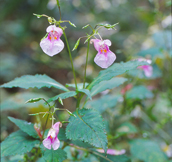
 Impatiens textori Balsaminaceae
Impatiens textori Balsaminaceae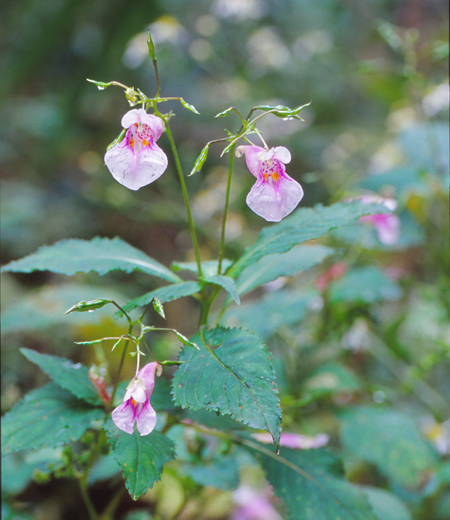 Annual herbs found in wet roadside near streams and waterside. Peduncles grow from petioles and bloom several red-purple flowers. The Japanese name Tsurifune-so was named after the dropping bell-like flowers resembling flower pod called tsurifune. Flowers are 3 to 4 cm and tips of petals open vertically. Have three petals and calyx and one of calyx are large sac-shaped and have spur (pouch like part on the back of petals) curled on the back. Leaves are 5 to 13 cm long, 2 to 6 cm width diamond shaped andand rhomboid oval shaped with long petioles, pointed tips with fine toothed margins (edges of leaves are like a teeth of saw). Stems are reddish and have thick nodes. After flowering, bear 1 to 2 cm long fruits and pop seeds at a touch when ripen.
Annual herbs found in wet roadside near streams and waterside. Peduncles grow from petioles and bloom several red-purple flowers. The Japanese name Tsurifune-so was named after the dropping bell-like flowers resembling flower pod called tsurifune. Flowers are 3 to 4 cm and tips of petals open vertically. Have three petals and calyx and one of calyx are large sac-shaped and have spur (pouch like part on the back of petals) curled on the back. Leaves are 5 to 13 cm long, 2 to 6 cm width diamond shaped andand rhomboid oval shaped with long petioles, pointed tips with fine toothed margins (edges of leaves are like a teeth of saw). Stems are reddish and have thick nodes. After flowering, bear 1 to 2 cm long fruits and pop seeds at a touch when ripen.
●Season Early September to about Mid October
●Height about 40 to 80 cm
●Place Trail 1, Trail 4, Trail 6, Ura-Takao, Oku-Takao, Minami-Takao -
Boenninghausenia japonica Rutaceae
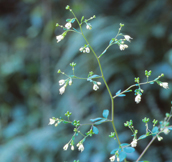
 Boenninghausenia japonica Rutaceae
Boenninghausenia japonica Rutaceae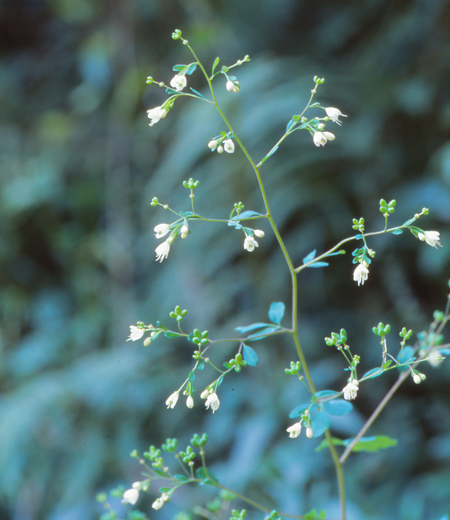 Perennial herbs (grow for several years from their same root system) found in tree shades and streamside in mountain. This is only grass plant in rutaceae native to Japan. Have half-transparent oil spots that are unique to plants in rutaceae family. Have strong scent and often used as anti-insect agent. Flowers are 5 mm in diameter with four petals and stamen protrude long. Color is white and bloom many on inflorescence. The Japanese name Matsukaze-so litearlly meaning pine breeze plant was named because it resemble pine branch looking wijnruit which is also a grass plants in rutaceae family native to Southern Europe. Leaves are tripinnately compound leaf, a set of three leaves divided into three branches. Each leaf is upside down egg-shaped and 1 to 2..5 cm long. Texture is soft and white on the back. After flowering, bear 3 mm long fruits split into four. Pop when ripen and some seeds inside.
Perennial herbs (grow for several years from their same root system) found in tree shades and streamside in mountain. This is only grass plant in rutaceae native to Japan. Have half-transparent oil spots that are unique to plants in rutaceae family. Have strong scent and often used as anti-insect agent. Flowers are 5 mm in diameter with four petals and stamen protrude long. Color is white and bloom many on inflorescence. The Japanese name Matsukaze-so litearlly meaning pine breeze plant was named because it resemble pine branch looking wijnruit which is also a grass plants in rutaceae family native to Southern Europe. Leaves are tripinnately compound leaf, a set of three leaves divided into three branches. Each leaf is upside down egg-shaped and 1 to 2..5 cm long. Texture is soft and white on the back. After flowering, bear 3 mm long fruits split into four. Pop when ripen and some seeds inside.
●Season Late August to about Early October
●Height about 50 to 80 cm
●Place Trail 1 to 6, Ura-Takao, Oku-Takao -
Pueraria lobata(kudzu) Leguminosae
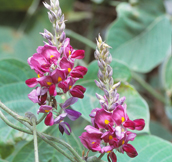
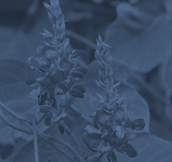 Pueraria lobata(kudzu) Leguminosae
Pueraria lobata(kudzu) Leguminosae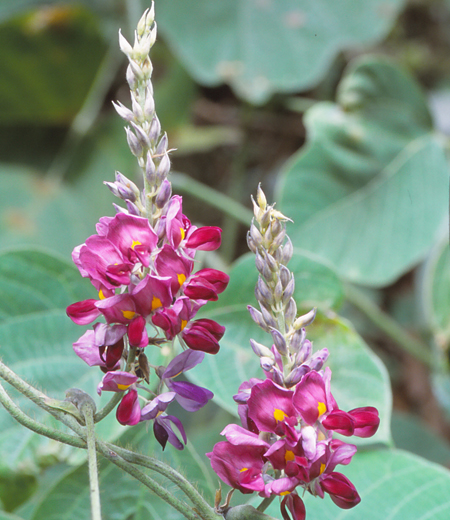 Perennial vines (grow for several years from their same root system) found in mountains and is a part of seven autumn leaves. Grow by twining around adjacent plants up to 10 m. Roots are thick and include high concentration of starch that makes powdered arrowroot. This was mainly from Kuzu area of Nara prefecture, hence the Japanese name kudzu. Also used in dry as a medicine for cold, kakkonto. Bloom many flowers on 10 to 20 cm inflorescence (flower stems without leaves). Flowers are 1..5 to 2 cm long and red-purple. Bloom from the bottom and slightly sweet scented. Three leaves create compound leaves and each leaf is 10 to 15 cm long. Roundy egg-shaped and some lobed in two or three and have white hair densely on the back of leaves. Young vine, stems, flowers or buds can be eaten as tempura.
Perennial vines (grow for several years from their same root system) found in mountains and is a part of seven autumn leaves. Grow by twining around adjacent plants up to 10 m. Roots are thick and include high concentration of starch that makes powdered arrowroot. This was mainly from Kuzu area of Nara prefecture, hence the Japanese name kudzu. Also used in dry as a medicine for cold, kakkonto. Bloom many flowers on 10 to 20 cm inflorescence (flower stems without leaves). Flowers are 1..5 to 2 cm long and red-purple. Bloom from the bottom and slightly sweet scented. Three leaves create compound leaves and each leaf is 10 to 15 cm long. Roundy egg-shaped and some lobed in two or three and have white hair densely on the back of leaves. Young vine, stems, flowers or buds can be eaten as tempura.
●Season Mid July to about Mid September
●Height Vines
●Place Trail 1, Trail 4, Tail 6, Jyataki and Ura-Takao -
Desmodium oldhamii Leguminosae
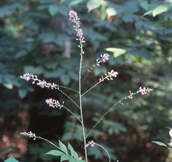
 Desmodium oldhamii Leguminosae
Desmodium oldhamii Leguminosae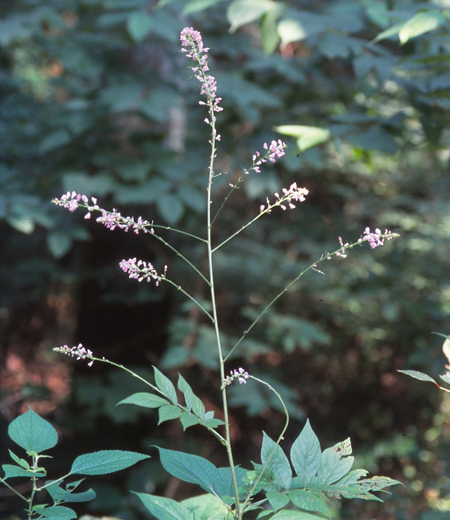 Perennial herbs (grow for several years from their same root system) found in forests in mountains. Fine hair on stems is sticky at a touch. Flowers are 1 cm long, pink and blooms randomly on flower stems (flower stems without leaves) are about 30 cm grow from tips of stems or petioles. Five to seven leaves alternate on stems like feather of birds. Each leaf of compound leaves is long egg-shaped and about 10 cm. The Japanese name Fuji-kanzo literally meaning wisteria sweetroot was named because flowers resemble wisteria and leaves resemble sweetroot. After flowering bear fruits called loment, an indehiscent legume (break apart into indehiscent, seed-bearing segment). Ripen fruits are brown and have densely hook-shaped hair which is carried by animals or clothes. The shape of loment is two-segmented half-moon shaped and about 2cm long, twice as large as the size of the similar plant desmodium podocarpum subsp. oxyphyllum.
Perennial herbs (grow for several years from their same root system) found in forests in mountains. Fine hair on stems is sticky at a touch. Flowers are 1 cm long, pink and blooms randomly on flower stems (flower stems without leaves) are about 30 cm grow from tips of stems or petioles. Five to seven leaves alternate on stems like feather of birds. Each leaf of compound leaves is long egg-shaped and about 10 cm. The Japanese name Fuji-kanzo literally meaning wisteria sweetroot was named because flowers resemble wisteria and leaves resemble sweetroot. After flowering bear fruits called loment, an indehiscent legume (break apart into indehiscent, seed-bearing segment). Ripen fruits are brown and have densely hook-shaped hair which is carried by animals or clothes. The shape of loment is two-segmented half-moon shaped and about 2cm long, twice as large as the size of the similar plant desmodium podocarpum subsp. oxyphyllum.
●Season August to about September
●Height about 50 cm to 1.5 m
●Place Trail 1 to 2, Trail 4 to 6, Mt. Inari, Ura-Takao, Oku-Takao -
Agrimonia pilosa Rosaceae
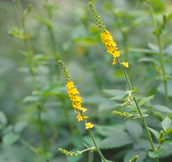
 Agrimonia pilosa Rosaceae
Agrimonia pilosa Rosaceae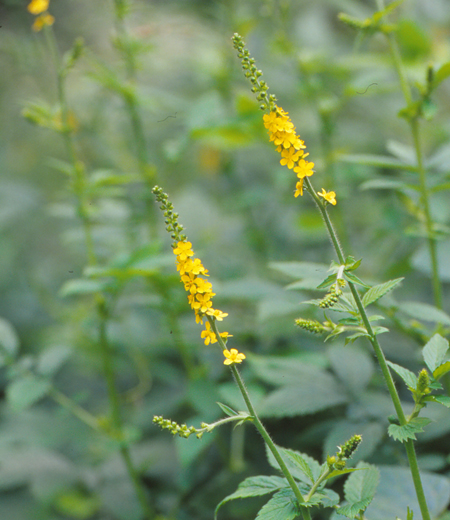 Perennial herbs (grow for several years from their same root system) found in wet grasslands and at roadside in mountains. Stems grow upright with hair. 10 to 20 cm flower stems grow from petioles and bloom small white flowers in flower spikes. This resemble gold mizuhiki, the decorative two tone paper cord (normally gold is used), hence the Japanese name Kin-mizuhiki literally meaning golden two tone paper cord decoration. Flowers are 0.7 to 1 cm in diameter with five petals and bloom from the bottom. Leaves are egg-like shape, 3 to 6 cm long. Five or nine leaves create feather of birds and alternate. Have many leaf glands on the back of leaves with toothed margins (edges of leaves are like a teeth of saw). After flowering, bear 3 cm long seeds. Fruits are hook-like bracts with many prickles and carried by sticking itself to animals and clothes.
Perennial herbs (grow for several years from their same root system) found in wet grasslands and at roadside in mountains. Stems grow upright with hair. 10 to 20 cm flower stems grow from petioles and bloom small white flowers in flower spikes. This resemble gold mizuhiki, the decorative two tone paper cord (normally gold is used), hence the Japanese name Kin-mizuhiki literally meaning golden two tone paper cord decoration. Flowers are 0.7 to 1 cm in diameter with five petals and bloom from the bottom. Leaves are egg-like shape, 3 to 6 cm long. Five or nine leaves create feather of birds and alternate. Have many leaf glands on the back of leaves with toothed margins (edges of leaves are like a teeth of saw). After flowering, bear 3 cm long seeds. Fruits are hook-like bracts with many prickles and carried by sticking itself to animals and clothes.
●Season Late July to about Late September
●Height about 50 cm to 1 m
●Place Trail 3, Ura-Takao, Oku-Takao -
Cremastra appendiculata Orchidaceae
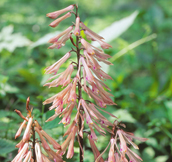
 Cremastra appendiculata Orchidaceae
Cremastra appendiculata Orchidaceae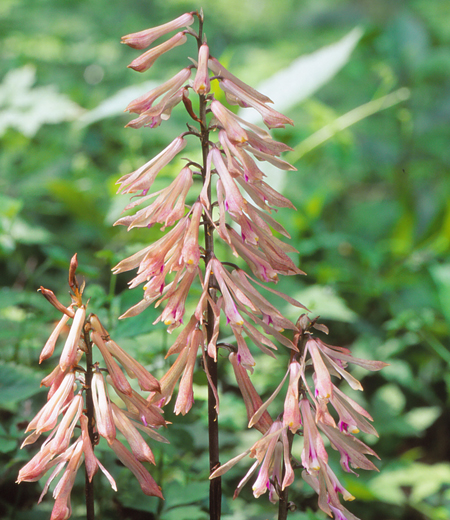 Perennial herbs (grow for several years from their same root system) found in dark areas including forests near streams in mountains. The Japanese name Saihai-ran literally meaning baton orchid because flowers resemble the baton samurai used in Warring States period to give orders to warriors. Flowers are elongated 3 cm long and bloom 10 to 20 flowers facing downward on the upper part of stems. The color of flowers is pinkish brown but some are red. Protruded petal is lobed in three. Gynostemium (the united stamen and pistil) and yellow pollen at its tips are inside of flowers. One oval-shaped 15 to 35 cm long leaf per flower and remain during winter. It is like thin large bamboo leaf and very appealing even during non-blooming seasons.
Perennial herbs (grow for several years from their same root system) found in dark areas including forests near streams in mountains. The Japanese name Saihai-ran literally meaning baton orchid because flowers resemble the baton samurai used in Warring States period to give orders to warriors. Flowers are elongated 3 cm long and bloom 10 to 20 flowers facing downward on the upper part of stems. The color of flowers is pinkish brown but some are red. Protruded petal is lobed in three. Gynostemium (the united stamen and pistil) and yellow pollen at its tips are inside of flowers. One oval-shaped 15 to 35 cm long leaf per flower and remain during winter. It is like thin large bamboo leaf and very appealing even during non-blooming seasons.
●Season Early June to about Early July
●Height about 30 to 50 cm
●Place Trail 1, Trail 3, Trail 6, Ura-Takao, Oku-Takao -
Ophiopogon planiscapus Liliaceae
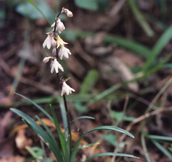
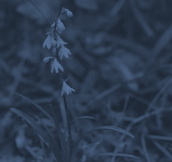 Ophiopogon planiscapus Liliaceae
Ophiopogon planiscapus Liliaceae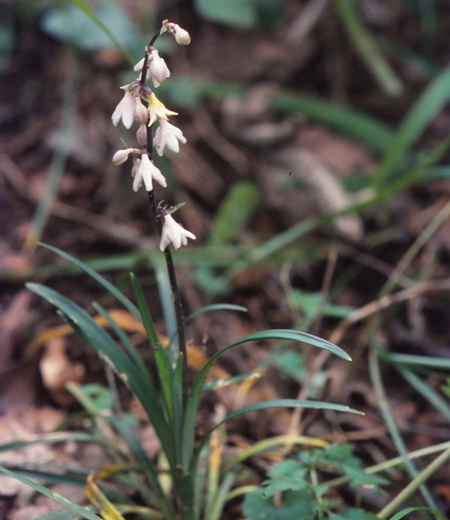 Perennial herbs (grow for several years from their same root system) found under evergreen trees or shady areas in mountains. Long vines grow underground and often found in clusters. The Japanese name Ooba-jyano-hige literally meaning large leaf beards of snakes was named because leaves resemble beards of snakes and this plant has wide and thick leaves compare to other plants in ophiopogon genes. Leaves grow from roots are elongated and 20 to 40 cm long. Have shiny surface but edges are rough. Flowers are 6 to 7 mm long and white or light purple. In Mt. Takao, white ones are more often found. Slightly curved flower stems are facing downward and bloom from the bottom ones. Skin of fruits drop at early stage and seeds are not covered with anything. Become grayish dark green when ripen.
Perennial herbs (grow for several years from their same root system) found under evergreen trees or shady areas in mountains. Long vines grow underground and often found in clusters. The Japanese name Ooba-jyano-hige literally meaning large leaf beards of snakes was named because leaves resemble beards of snakes and this plant has wide and thick leaves compare to other plants in ophiopogon genes. Leaves grow from roots are elongated and 20 to 40 cm long. Have shiny surface but edges are rough. Flowers are 6 to 7 mm long and white or light purple. In Mt. Takao, white ones are more often found. Slightly curved flower stems are facing downward and bloom from the bottom ones. Skin of fruits drop at early stage and seeds are not covered with anything. Become grayish dark green when ripen.
●Season Late June to about Mid July
●Height about 15 to 25 cm
●Place Trail 2 to 3, Trail 5, Kita-Takao -
Liriope platyphylla Liliaceae
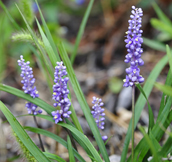
 Liriope platyphylla Liliaceae
Liriope platyphylla Liliaceae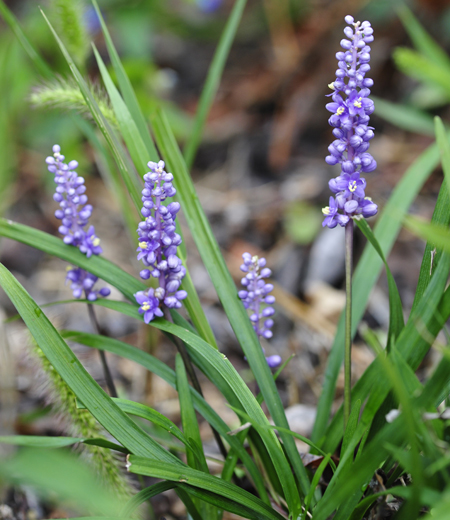 Perennial evergreen herbs (grow for several years from their same root system) found at forest edges and tree shades in forests in mountains and also used as ground cover at parks and gardens. Have many radical leaves (leaves grow from roots) and become a large rootstock and grow 8 to 12 cm long flower stems and bloom 8 mm in diameter small flowers in clusters. The color is light purple with six petals and six yellow stamens. Leaves are skinny 30 to 50 cm long, 0..8 to 1..2 cm width and deep green and shiny surface. Grow in shrubs and leaves resembles orchid, hence the Japanese name Yabu-ran literally meaning shrub orchid. After flowering, bear seeds looks like shiny fruits. Seeds are 6 to 7 mm in diameter spherical shaped and the color is green at first and turns to black-purple when ripen in autumn.
Perennial evergreen herbs (grow for several years from their same root system) found at forest edges and tree shades in forests in mountains and also used as ground cover at parks and gardens. Have many radical leaves (leaves grow from roots) and become a large rootstock and grow 8 to 12 cm long flower stems and bloom 8 mm in diameter small flowers in clusters. The color is light purple with six petals and six yellow stamens. Leaves are skinny 30 to 50 cm long, 0..8 to 1..2 cm width and deep green and shiny surface. Grow in shrubs and leaves resembles orchid, hence the Japanese name Yabu-ran literally meaning shrub orchid. After flowering, bear seeds looks like shiny fruits. Seeds are 6 to 7 mm in diameter spherical shaped and the color is green at first and turns to black-purple when ripen in autumn.
●Season Mid August to about Early October
●Height about 30 to 50 cm
●Place Trail 2, Trail 5, Ura-Takao -
Tricyrtis macropoda Liliaceae
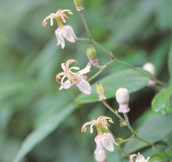
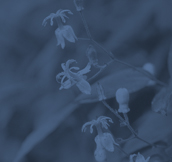 Tricyrtis macropoda Liliaceae
Tricyrtis macropoda Liliaceae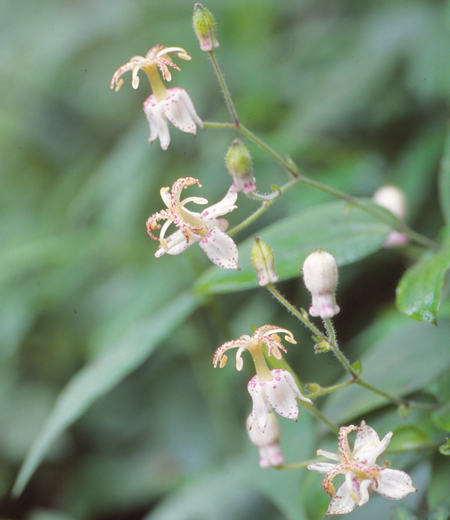 Perennial herbs (grow for several years from their same root system) found at forest edges and in forests in mountains. Flower stems (only bloom flowers without any leaves) grow at the tips of stems or from petioles and bloom some flowers facing upward. Flowers are 3 cm in diameter and have purple spots on white petals. This spots resemble the pattern of the chest of lesser cuckoo, hence the Japanese name Yama-hototogisu literally meaning lesser cuckoo in mountains. Six petals curled downward and stamens and pistils protrude like fountains. Leaves are 8 to 13 cm oval-shaped with pointed tip but curl stems at the base. Stems have hair facing downward but amount of hair vary to each plant. After flowering, bear 3 cm long fruits. Split from the upper side and pop small oval-shaped seeds when ripen.
Perennial herbs (grow for several years from their same root system) found at forest edges and in forests in mountains. Flower stems (only bloom flowers without any leaves) grow at the tips of stems or from petioles and bloom some flowers facing upward. Flowers are 3 cm in diameter and have purple spots on white petals. This spots resemble the pattern of the chest of lesser cuckoo, hence the Japanese name Yama-hototogisu literally meaning lesser cuckoo in mountains. Six petals curled downward and stamens and pistils protrude like fountains. Leaves are 8 to 13 cm oval-shaped with pointed tip but curl stems at the base. Stems have hair facing downward but amount of hair vary to each plant. After flowering, bear 3 cm long fruits. Split from the upper side and pop small oval-shaped seeds when ripen.
●Season Mid August to about Early October
●Height about 40 to 70 cm
●Place Trail 2, Trail 4, Trail 6, Ura-Takao -
Pollia japonica Commelinaceae
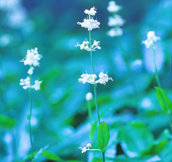
 Pollia japonica Commelinaceae
Pollia japonica Commelinaceae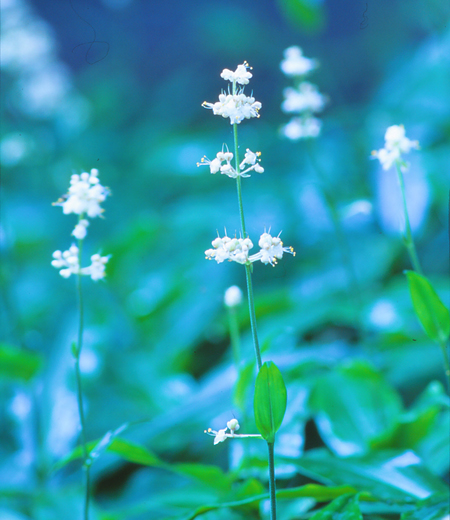 Perennial herbs (grow for several years from their same root system) found at forest edges near streams and in wet forests. Grow long upright stem and bloom many white small flowers. Stems are hairy and rough texture. White underground stems grow horizontally on top of ground. Flowers are 6 to 8 cm in diameter and five to six in tiers creating clusters. Flowers are ephemeral flowers that bloom only one day. Male flower and bisexual flower are mixed. Leaves are elongated oval-shaped, 15 to 30 cm and open in the middle of stem in whorls of six or seven leaves. The Japanese name Yabu-myoga literally meaning shrubs myoga because leaves of this plant resemble those of myoga and grow in shrubs. After flowering, bear spherical fruits, about 5 mm in diameter with full of moisture. Fruits are white at first and become indigo blue in autumn.
Perennial herbs (grow for several years from their same root system) found at forest edges near streams and in wet forests. Grow long upright stem and bloom many white small flowers. Stems are hairy and rough texture. White underground stems grow horizontally on top of ground. Flowers are 6 to 8 cm in diameter and five to six in tiers creating clusters. Flowers are ephemeral flowers that bloom only one day. Male flower and bisexual flower are mixed. Leaves are elongated oval-shaped, 15 to 30 cm and open in the middle of stem in whorls of six or seven leaves. The Japanese name Yabu-myoga literally meaning shrubs myoga because leaves of this plant resemble those of myoga and grow in shrubs. After flowering, bear spherical fruits, about 5 mm in diameter with full of moisture. Fruits are white at first and become indigo blue in autumn.
●Season Mid August to about Mid September
●Height about 50 cm to 1 m
●Place Trail 1 to 2, Trail 4 to 6, Mt. Inari, Jyataki, Ura-Takao -
Cirsium microspicatum Compositae
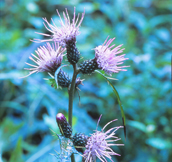
 Cirsium microspicatum Compositae
Cirsium microspicatum Compositae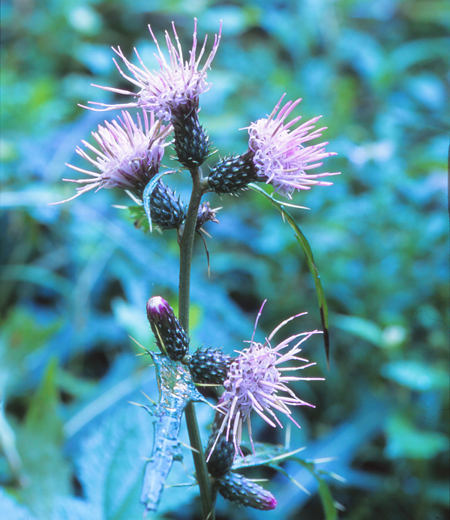 They are a perennial plant that grows in the pool of the forests and in the forests, and along the mountain streams in a mountain district (Perennial plant takes several years to grow). While Cirsium spicatum (Yama-azami) inhabit in Kyushu and Shikoku regions, they grow much in Kanto (ancient name is Azua) region. This is why they are named. The flower consists of lots of dense small flowers in cluster, which is capitulum (Touka: a flower consisting of small dense tubular flowers), and 1 to 3 of them bloom downward at the top of the stalk. The flowers are tinged with red-purple with a cylindrical involucre (Soho: a portion like a bud to cover). The cylindrical involucre is about 1.5 cm long with dense trichome and sticky a little. The leaves grown from the stalk are thin and long about 20 cm long, split pinnately (Ujo: leaves like bird’s wings, a pinnately compound leaf) with the sharp top and the prickled edges. The radical leaf (KON-SEI-YO: leaf spring up from the place about stalk root) bears white-tinged patterns on it, and withers during the blossom season. When the blossom season is over, they produce the seed with white cottony trichome around it. In the winter, we can see ‘Shimobashira’ (ice column). This is caused by the liquid inside the withered stems get frozen to be swollen. Consequently, ice columns are like an ice bloom.
They are a perennial plant that grows in the pool of the forests and in the forests, and along the mountain streams in a mountain district (Perennial plant takes several years to grow). While Cirsium spicatum (Yama-azami) inhabit in Kyushu and Shikoku regions, they grow much in Kanto (ancient name is Azua) region. This is why they are named. The flower consists of lots of dense small flowers in cluster, which is capitulum (Touka: a flower consisting of small dense tubular flowers), and 1 to 3 of them bloom downward at the top of the stalk. The flowers are tinged with red-purple with a cylindrical involucre (Soho: a portion like a bud to cover). The cylindrical involucre is about 1.5 cm long with dense trichome and sticky a little. The leaves grown from the stalk are thin and long about 20 cm long, split pinnately (Ujo: leaves like bird’s wings, a pinnately compound leaf) with the sharp top and the prickled edges. The radical leaf (KON-SEI-YO: leaf spring up from the place about stalk root) bears white-tinged patterns on it, and withers during the blossom season. When the blossom season is over, they produce the seed with white cottony trichome around it. In the winter, we can see ‘Shimobashira’ (ice column). This is caused by the liquid inside the withered stems get frozen to be swollen. Consequently, ice columns are like an ice bloom.
●Season Early September to about Late October
●Height about 1.5 to 2 m
●Place Trail 1 and 2, Ura-Takao, Oku-Takao -
Pertya robusta Compositae
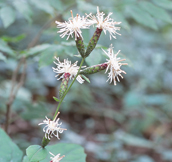
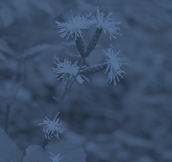 Pertya robusta Compositae
Pertya robusta Compositae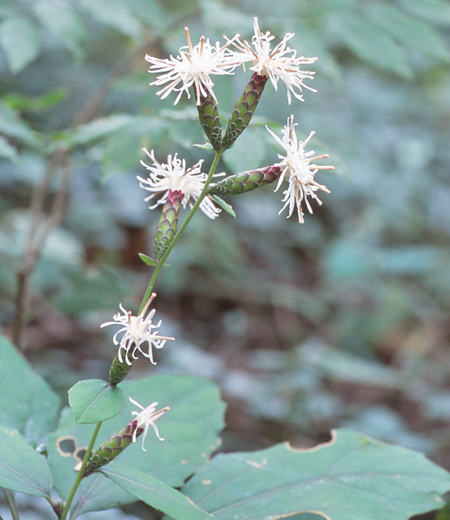 They are a perennial plant that grows at the arid places such as in the pool of the forests and in the forests at the mountain area (Perennial plant takes several years to grow). The rhizome (Konkei) creeps sideways and the stalks are not split but expand straight. The flower consists of apitulum (Touka: a flower consisting of small dense tubular flowers) of 10 small flowers in cluster, and 5 to 6 of them are on the upper part of the stalk. The flower is tinged with white with the tips split into 5 and curled back. A circular cylindrical shape involucre (Soho: a portion like a bud to cover) lie below the flower, about 1.7 to 2.7 cm long. The leaf is elliptically-shaped like the one of Quercus dentate, about 10 to 20 cm long, with coarse sawtooth at the edge (Kyoshi: tooth-like rough part like a saw at the root of a leaf). They have a long stalk and the leaves grow alternative in cluster in the middle of the stalk. When the flowers wither, they bear the seeds about 1.4 cm long and with floss. In the winter, the liquid inside the withered stems get frozen to be swollen to be ‘Shimobashira’ (Ice Flower).
They are a perennial plant that grows at the arid places such as in the pool of the forests and in the forests at the mountain area (Perennial plant takes several years to grow). The rhizome (Konkei) creeps sideways and the stalks are not split but expand straight. The flower consists of apitulum (Touka: a flower consisting of small dense tubular flowers) of 10 small flowers in cluster, and 5 to 6 of them are on the upper part of the stalk. The flower is tinged with white with the tips split into 5 and curled back. A circular cylindrical shape involucre (Soho: a portion like a bud to cover) lie below the flower, about 1.7 to 2.7 cm long. The leaf is elliptically-shaped like the one of Quercus dentate, about 10 to 20 cm long, with coarse sawtooth at the edge (Kyoshi: tooth-like rough part like a saw at the root of a leaf). They have a long stalk and the leaves grow alternative in cluster in the middle of the stalk. When the flowers wither, they bear the seeds about 1.4 cm long and with floss. In the winter, the liquid inside the withered stems get frozen to be swollen to be ‘Shimobashira’ (Ice Flower).
●Season Mid September to about Mid October
●Height about 30 to 70 cm
●Place Trail 1 to 6, Mt.Inari, Jyataki, Ura-Takao, Oku-Takao -
Rhynchospermum verticillatum Compositae
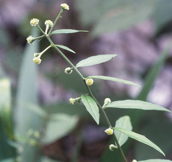
 Rhynchospermum verticillatum Compositae
Rhynchospermum verticillatum Compositae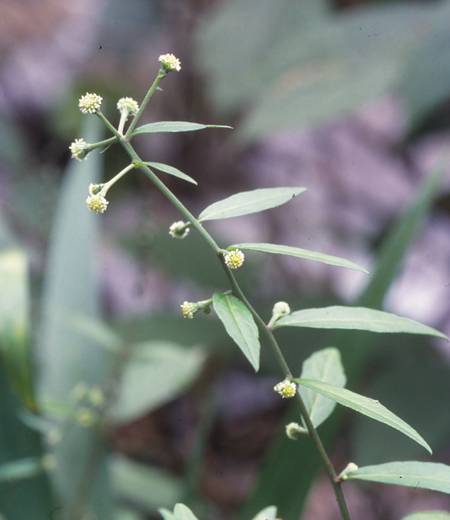 They are a perennial plant that grows in the pool of the forests and at the roadsides along the mountain streams at the mountain area (Perennial plant takes several years to grow). Their flowers come into high season around the time when the autumn is come. This is the reason for the name. When the stalk grows to be about 1 m high, it shoots 2 to 4 of offshoots and bears a small flower at the top of the short stem growing from the side of the leaf. The flower consists of apitulum (Touka: a flower consisting of small dense tubular flowers, to be like one flower), about 5 mm, tinged with pale yellow-green. In its center, gathers a tubular flower (Toujoka: tubular corolla that gathers dense in the center, also a flower with no flower petals) with the tip split into 5, while small white flower petals like protuberance around it queue up in 2 lines to surround. The leaf is thin and long elliptically-shaped, about 7 to 15 cm long, about 2 to 3 cm wide with the sharp top, and has hard and short trichome on (Shiga: a gyrose jagged part) both surfaces, rough feeling to touch with a gyrose tooth(at the edge of the upper portion. When he flowers wither, they bear the elliptically-shaped, seeds about 2.5 mm long.
They are a perennial plant that grows in the pool of the forests and at the roadsides along the mountain streams at the mountain area (Perennial plant takes several years to grow). Their flowers come into high season around the time when the autumn is come. This is the reason for the name. When the stalk grows to be about 1 m high, it shoots 2 to 4 of offshoots and bears a small flower at the top of the short stem growing from the side of the leaf. The flower consists of apitulum (Touka: a flower consisting of small dense tubular flowers, to be like one flower), about 5 mm, tinged with pale yellow-green. In its center, gathers a tubular flower (Toujoka: tubular corolla that gathers dense in the center, also a flower with no flower petals) with the tip split into 5, while small white flower petals like protuberance around it queue up in 2 lines to surround. The leaf is thin and long elliptically-shaped, about 7 to 15 cm long, about 2 to 3 cm wide with the sharp top, and has hard and short trichome on (Shiga: a gyrose jagged part) both surfaces, rough feeling to touch with a gyrose tooth(at the edge of the upper portion. When he flowers wither, they bear the elliptically-shaped, seeds about 2.5 mm long.
●Season Mid September to about Mid October
●Height about 50 to 90 cm
●Place Trail 1 to 6, Mt. Inari, Jyataki, Ura-Takao -
Vicia unijuga Leguminosae
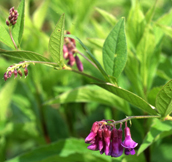
 Vicia unijuga Leguminosae
Vicia unijuga Leguminosae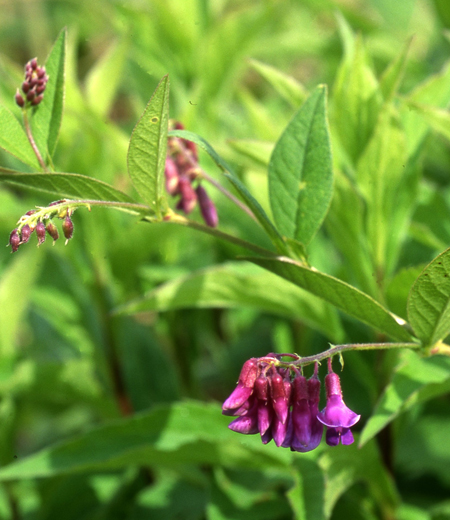 Perennial herbs (grow for several years from their same root system) found in sunny forest edges and riverbanks. Upright stems have fin-like ribs. Flowers are 1..5 cm long and tips are pointed like butterflies. Color of flowers is red-purple and bloom on 2 to 4 cm inflorescence. Leaves are two-leaves compound leaves and alternate. Each leaf is 3 to 7 cm long, long egg-shaped, hairy and with short petioles. The Japanese name Nanten-hagi was named because the shape of leaves resembles nandina domestica (nanten in Japanese and hagi is bush clover). This is also called Futaba-hagi literally meaning two leaves bush clover named after the two compounded leaves. After flowering, bear 3 cm long loment like peas with three to seven seeds. Sprout in spring is called Azukina and can be eaten as wild vegetable.
Perennial herbs (grow for several years from their same root system) found in sunny forest edges and riverbanks. Upright stems have fin-like ribs. Flowers are 1..5 cm long and tips are pointed like butterflies. Color of flowers is red-purple and bloom on 2 to 4 cm inflorescence. Leaves are two-leaves compound leaves and alternate. Each leaf is 3 to 7 cm long, long egg-shaped, hairy and with short petioles. The Japanese name Nanten-hagi was named because the shape of leaves resembles nandina domestica (nanten in Japanese and hagi is bush clover). This is also called Futaba-hagi literally meaning two leaves bush clover named after the two compounded leaves. After flowering, bear 3 cm long loment like peas with three to seven seeds. Sprout in spring is called Azukina and can be eaten as wild vegetable.
●Season June to about October
●Height about 30 to 60 cm
●Place Ura-Takao -
Amphicarpaea edgeworthii var. japonica Leguminosae
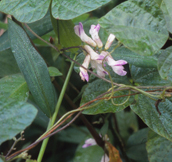
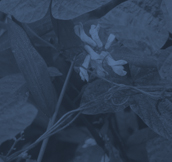 Amphicarpaea edgeworthii var. japonica Leguminosae
Amphicarpaea edgeworthii var. japonica Leguminosae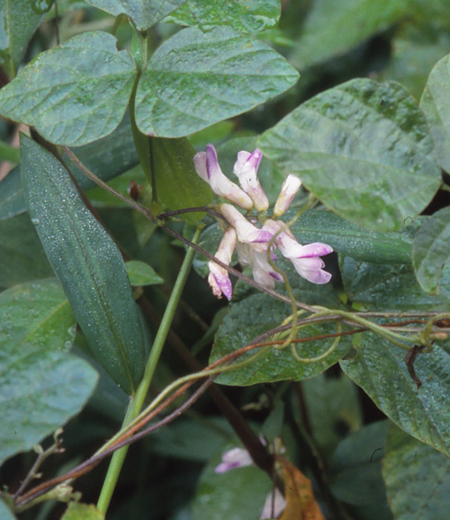 They are an annual plant that grows in the pool of the forests and at the grasslands in sunny mountain district. The stalk grows thickly downward paraphyllium and is thin and long to expand about 1 m to tangle in the other vegetation. We see them mostly in thicket, and then this is why they are named. The flower is about 2 cm long with the top being like a butterfly-shaped. The whitish edge of the flower petal is dark purple color and some are on inflorescence (Kajo: stalk blooming flowers) grown from the side of the leaf. Another characteristic is that except this flower, they have cleistogamous flower (Heisaka: the flower which does not blossom but pollinates itself) both on the ground and at the underground stem. The leaf consists of 3 as one and grows alternative. Lobules are wide egged-shaped about 3 to 6 cm long (Shoyo: each one that is leaf-shaped and leaf like one consisting of more than a few leaves) has paraphyllium to grow. When the flowers wither, they bear the hull-shaped seeds. When matured, the seeds are split half out to produce quail-egged shaped seedlings with black patterns.
They are an annual plant that grows in the pool of the forests and at the grasslands in sunny mountain district. The stalk grows thickly downward paraphyllium and is thin and long to expand about 1 m to tangle in the other vegetation. We see them mostly in thicket, and then this is why they are named. The flower is about 2 cm long with the top being like a butterfly-shaped. The whitish edge of the flower petal is dark purple color and some are on inflorescence (Kajo: stalk blooming flowers) grown from the side of the leaf. Another characteristic is that except this flower, they have cleistogamous flower (Heisaka: the flower which does not blossom but pollinates itself) both on the ground and at the underground stem. The leaf consists of 3 as one and grows alternative. Lobules are wide egged-shaped about 3 to 6 cm long (Shoyo: each one that is leaf-shaped and leaf like one consisting of more than a few leaves) has paraphyllium to grow. When the flowers wither, they bear the hull-shaped seeds. When matured, the seeds are split half out to produce quail-egged shaped seedlings with black patterns.
●Season September to about October
●Height – climbing plant
●Place Trail 1, Trail 4 to 6, Ura-Takao -
Cimicifuga simplex Ranunculaceae
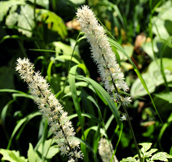
 Cimicifuga simplex Ranunculaceae
Cimicifuga simplex Ranunculaceae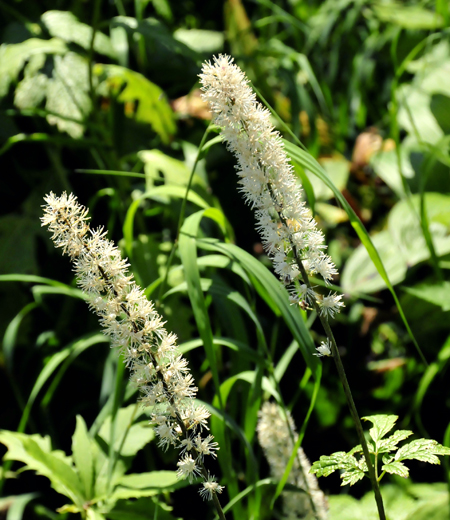 They are perennial plant that grows under the trees of mountain district and along the mountain stream. (Perennial plant takes several years to grow). They bear spikes (Kasui: small flowers gathering to be like head of plant) brush-shaped about 10 to 30 cm at the grown-high stalk. The spikes hold more than 150 flowers about 5 to 7 cm long. Though they resemble Cimicifuga japonica in the same group, the good difference to distinguish is that Cimicifuga simplex’s leaves differ from the ones of Cimicifuga japonica, and Cimicifuga simplex’s flowers have a stalk about 1 cm long. The leaf consists three as one named compound leaf, with a long stalk growing alternative to stem. Lobules (Shoyo: each one that is leaf-shaped and leaf like one consisting of more than a few leaves) is egged-shaped about 3 to 8 cm long, has a sharp tip and with spiny sawtooth at the edge (Kyoshi: tooth-like rough part like a saw at the root of a leaf). How they are named is people boiled the fresh leaves and immersed them in ice water to eat, and then they are called ‘Cimicifuga simplex’ (Sarashina-shoma). Shoma is a Chinese name. After flowers wither, they bear the seeds about 1 cm long. When matured, the seeds get split up and produce the seeds with shallow wrinkles.
They are perennial plant that grows under the trees of mountain district and along the mountain stream. (Perennial plant takes several years to grow). They bear spikes (Kasui: small flowers gathering to be like head of plant) brush-shaped about 10 to 30 cm at the grown-high stalk. The spikes hold more than 150 flowers about 5 to 7 cm long. Though they resemble Cimicifuga japonica in the same group, the good difference to distinguish is that Cimicifuga simplex’s leaves differ from the ones of Cimicifuga japonica, and Cimicifuga simplex’s flowers have a stalk about 1 cm long. The leaf consists three as one named compound leaf, with a long stalk growing alternative to stem. Lobules (Shoyo: each one that is leaf-shaped and leaf like one consisting of more than a few leaves) is egged-shaped about 3 to 8 cm long, has a sharp tip and with spiny sawtooth at the edge (Kyoshi: tooth-like rough part like a saw at the root of a leaf). How they are named is people boiled the fresh leaves and immersed them in ice water to eat, and then they are called ‘Cimicifuga simplex’ (Sarashina-shoma). Shoma is a Chinese name. After flowers wither, they bear the seeds about 1 cm long. When matured, the seeds get split up and produce the seeds with shallow wrinkles.
●Season Late September to about Late October
●Height about 60cm to 1.2 m
●Place Trail 1, Trail 4 to 6, Mt.Inari, Ura-Takao, Oku-Takao -
Amaryllidaceae Amaryllidaceae
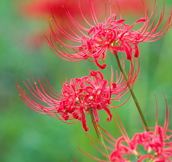
 Amaryllidaceae Amaryllidaceae
Amaryllidaceae Amaryllidaceae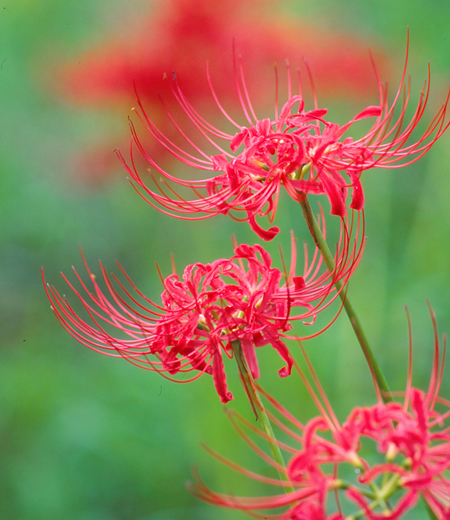 They are perennial plant that grows in clusters in the river bank, footpath between rice fields, and graveyards (Perennial plant takes several years to grow). It is thought that they were imported from ancient China. The reason for their name is that around the time of autumn during equinoctial week, they bear bright red flowers. They also have another name ‘Lycoris radiata’ which means the unworldly red flower in the Lotus Sutra. At the top of the upright-growing flower stalk (Kakei: stem of flower bearing only flowers without leaves) sprouting from the bulb (Rinkei: a modified leaf by nutrient accumulation being attached firmly to short stalk), 5 to 7 flowers bloom in a cluster. The flower has 6 thin flower petals about 4 centimeters long rolled back and a male stamen projects long. No leaves sprout during blooming, grow in latest autumn, pass the winter through, and wither in the next spring. The leaf is thin and long about 30 to 60 cm long, 6 to 8 mm wide. The leaves are dark shiny green color with the center in whitish color along the leaf vein. Entire portions of this plant contain poisonous elements, especially much in discoid stem (bulb). When eaten by mistake, this poison brings about the symptoms such as vomiting and diarrhea, in some cases, may lead to death.
They are perennial plant that grows in clusters in the river bank, footpath between rice fields, and graveyards (Perennial plant takes several years to grow). It is thought that they were imported from ancient China. The reason for their name is that around the time of autumn during equinoctial week, they bear bright red flowers. They also have another name ‘Lycoris radiata’ which means the unworldly red flower in the Lotus Sutra. At the top of the upright-growing flower stalk (Kakei: stem of flower bearing only flowers without leaves) sprouting from the bulb (Rinkei: a modified leaf by nutrient accumulation being attached firmly to short stalk), 5 to 7 flowers bloom in a cluster. The flower has 6 thin flower petals about 4 centimeters long rolled back and a male stamen projects long. No leaves sprout during blooming, grow in latest autumn, pass the winter through, and wither in the next spring. The leaf is thin and long about 30 to 60 cm long, 6 to 8 mm wide. The leaves are dark shiny green color with the center in whitish color along the leaf vein. Entire portions of this plant contain poisonous elements, especially much in discoid stem (bulb). When eaten by mistake, this poison brings about the symptoms such as vomiting and diarrhea, in some cases, may lead to death.
●Season Mid September to about Late September
●Height about 30 to 50 cm
●Place Ura-Takao,Oku-Takao -
Torreya nucifera Taxaceae
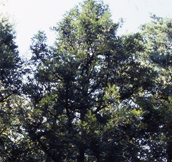
 Torreya nucifera Taxaceae
Torreya nucifera Taxaceae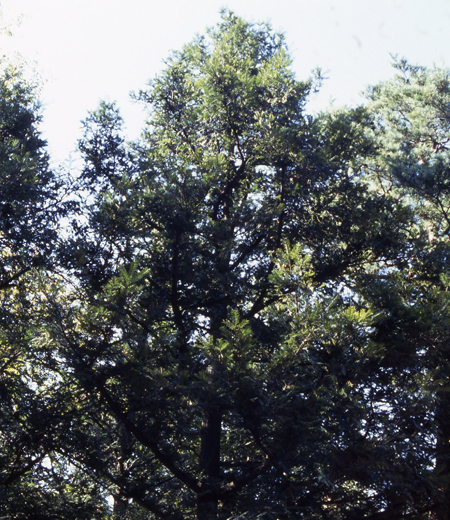 They are ever green arboreal that grows in mountains. Cortex of seedling is pale grey and smooth feeling to touch but when matured, they are divided to be peeled off likely oblong in line. The trunks are about 2 m wide, their lumbers are superior in close and having durability, and so they are widely used for construction materials. Their leaves are about 2 to 3 cm long, about 2 to 3 cm wide and long. They are very tough and luster with the top of them is sharp. When we touch them, it is painful for us unlike Dog Torreya. Their blossom seasons are about April to May, and a dioecious plant (Shiyuuisyu). They have a male flower beside the leaf of the branch that grew the previous year, and a female flower at the top of the branch.Their fruits are elliptically-shaped about 2 to 4 cm long, an aril (Kahisyu) like lichen covers seeds, and next October they are matured. Their seeds are very spicy and delicious when removed of astringent taste and roasted.
They are ever green arboreal that grows in mountains. Cortex of seedling is pale grey and smooth feeling to touch but when matured, they are divided to be peeled off likely oblong in line. The trunks are about 2 m wide, their lumbers are superior in close and having durability, and so they are widely used for construction materials. Their leaves are about 2 to 3 cm long, about 2 to 3 cm wide and long. They are very tough and luster with the top of them is sharp. When we touch them, it is painful for us unlike Dog Torreya. Their blossom seasons are about April to May, and a dioecious plant (Shiyuuisyu). They have a male flower beside the leaf of the branch that grew the previous year, and a female flower at the top of the branch.Their fruits are elliptically-shaped about 2 to 4 cm long, an aril (Kahisyu) like lichen covers seeds, and next October they are matured. Their seeds are very spicy and delicious when removed of astringent taste and roasted.
●Height about 20 to 30 m
●Place Trail 3 and 4, Ura-Takao
